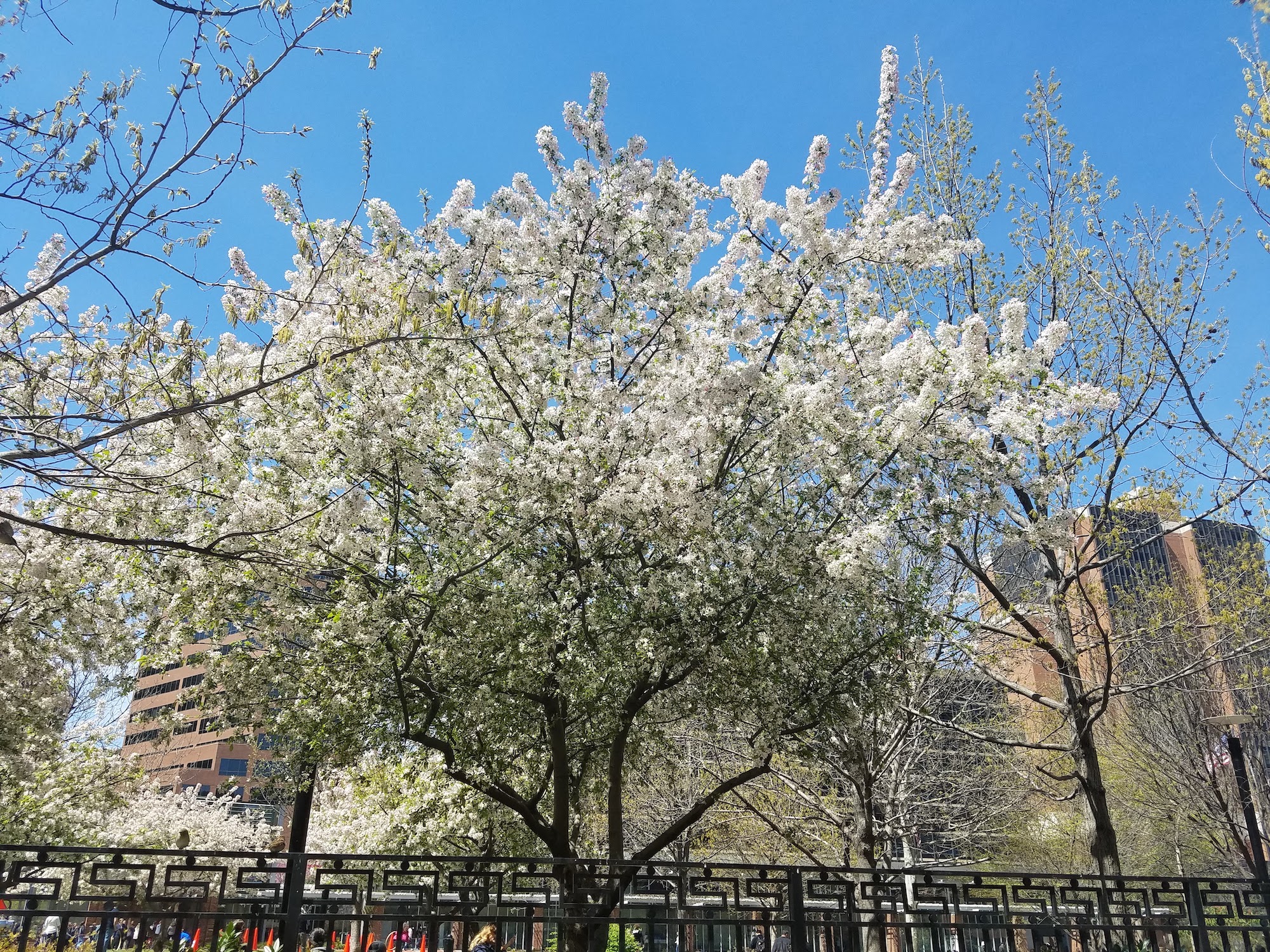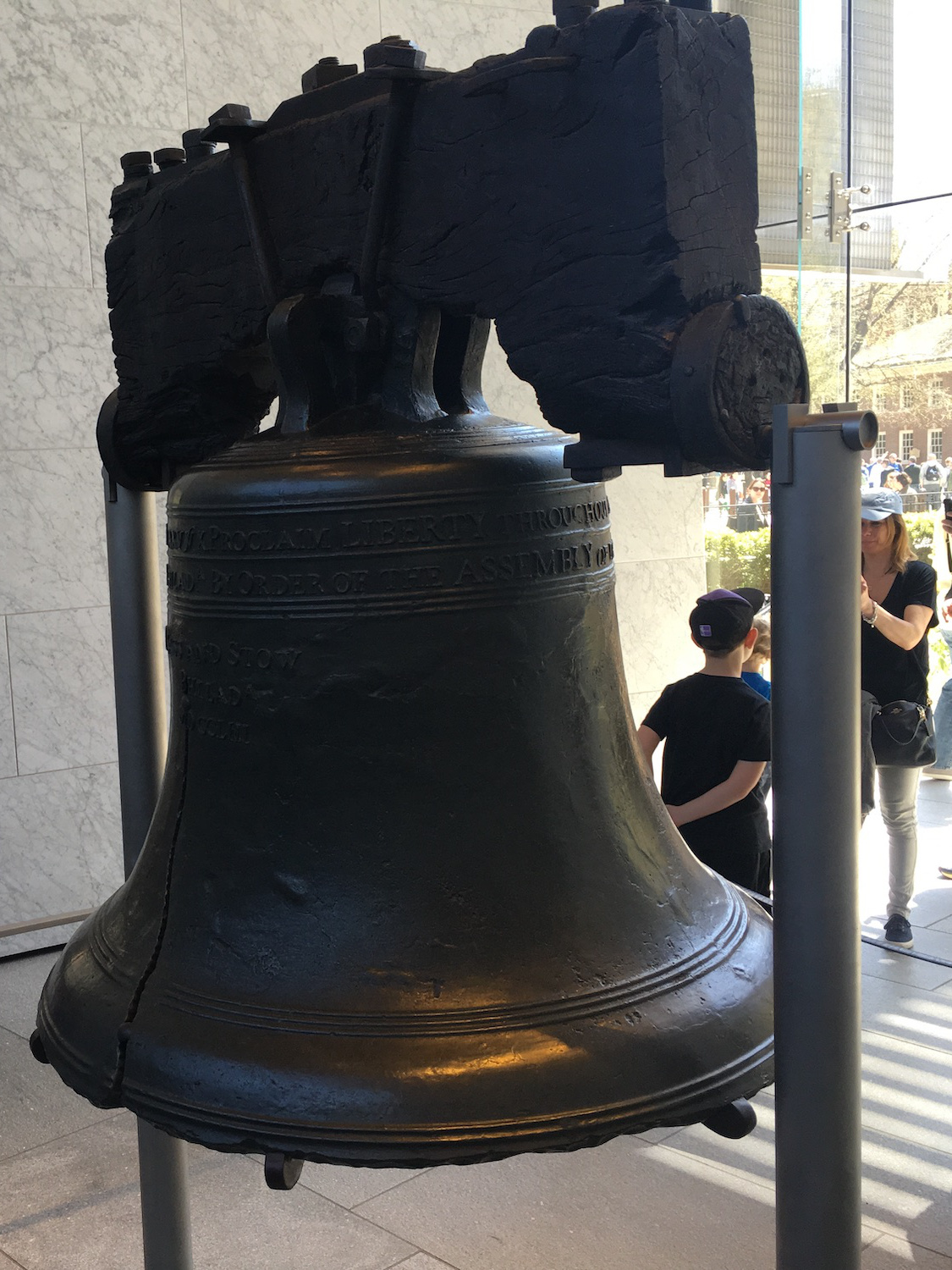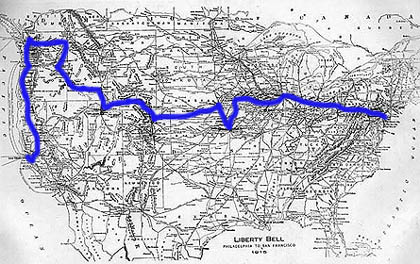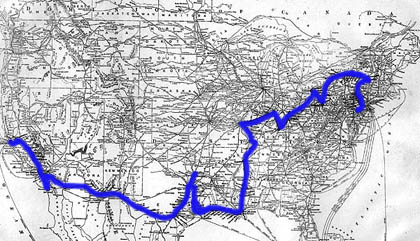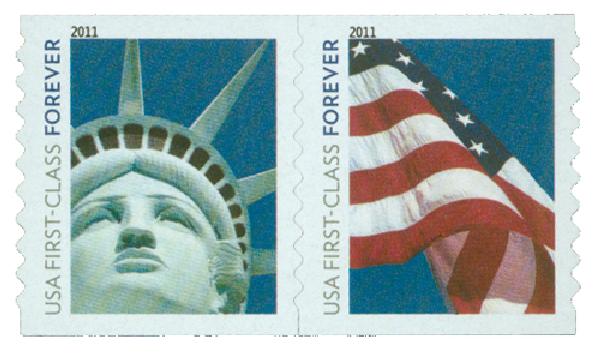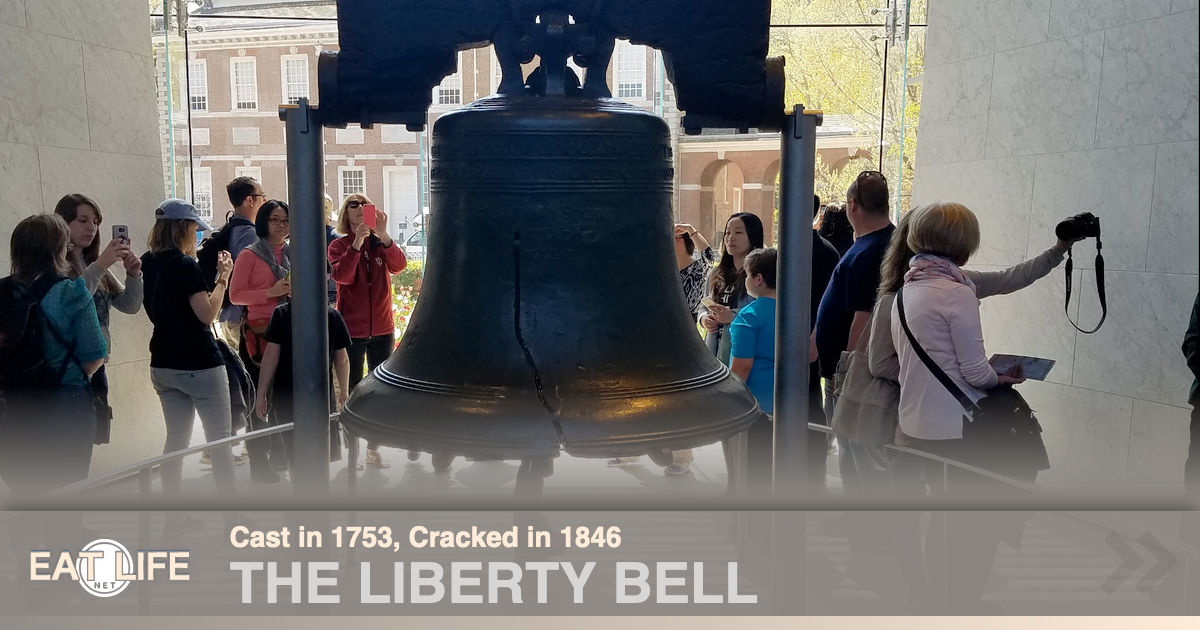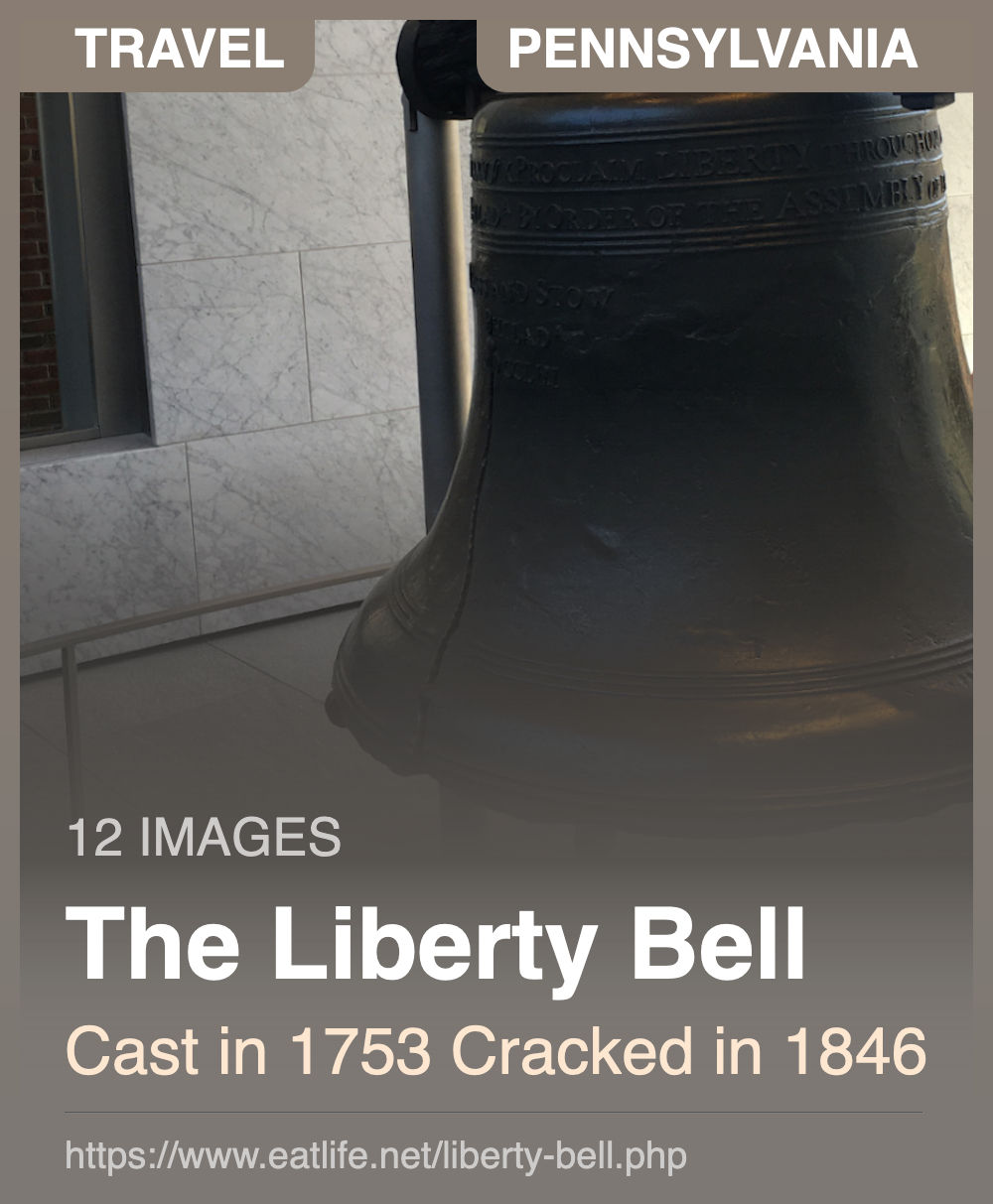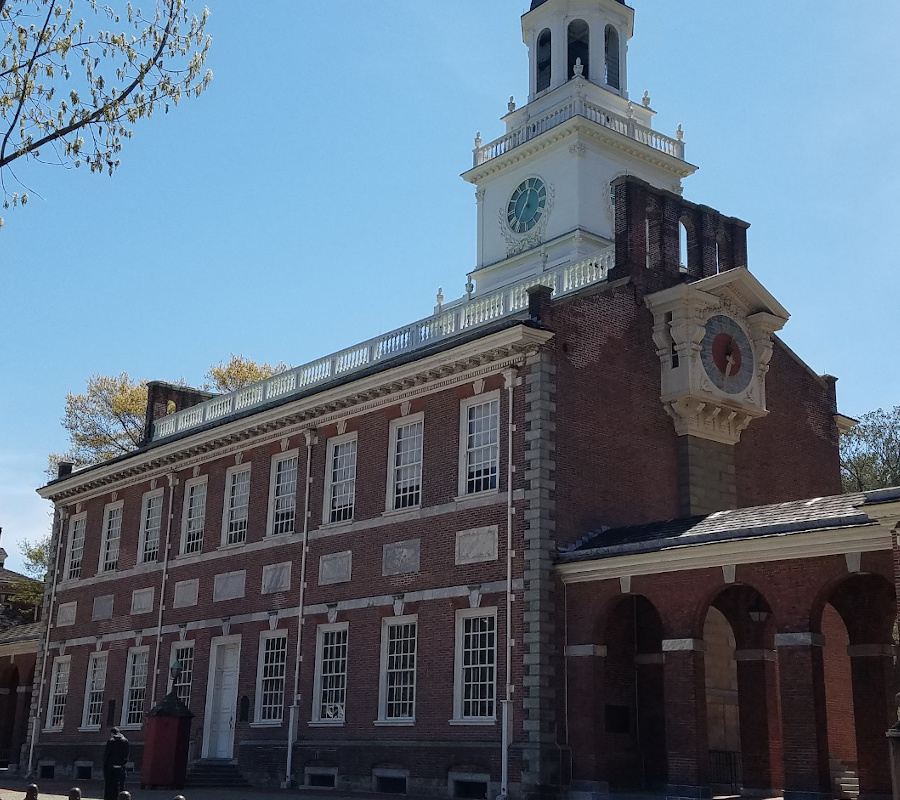The Liberty Bell: 1753
The Liberty Bell is a familiar symbol of freedom in the United States. It was ordered by the Pennsylvania Assembly in 1751 to commemorate the 50-year anniversary of William Penn's 1701 Charter of Privileges; it was to be installed in 1752 in the Pennsylvania State House, now known as Independence Hall. The bell was cast in London, England and then shipped to Pennsylvania.Soon after it arrived, the English bell cracked. In 1753, a new bell was cast from the metal of the English bell by local craftsmen John Pass and John Stow. Their names and the year in Roman numerals, MDCCLIII, are marked on the bell. It also has a Bible verse written on it: "Proclaim LIBERTY throughout all the Land unto all the inhabitants thereof" (Leviticus 25:10).
On June 7, 1753, the bell was hung in the tower of Independence Hall. In 1777, during the American Revolution, British troops captured Philadelphia. For safekeeping, the bell was moved to Zion's Reformed Church in Allentown, PA. It was returned to Philadelphia in 1778.
In the early 1800s, people who wanted to outlaw slavery called it the "Liberty Bell" and used it as a symbol for their campaign.
In 1846, another crack began to develop in the bell, and it was repaired. It rang for George Washington's birthday on February 23, 1846, but then it cracked again. In order to repair the bell, a slot was carved along the length of the crack that prevented the two sides of the bell from vibrating against each other. Two rivets were inserted in this slot to control the vibration of the two sides and restore the bell's tonal quality.
The bell traveled around the country after the Civil War (1861-1865) but since 1915 it has remained in Philadelphia. Today, the Liberty Bell is on permanent display in a visitor center next to Independence Hall.
Liberty Bell facts and figures:
- The bell is an alloy, or a mix of metals; it is made of 70% copper, 25% tin, and also has zinc, lead, arsenic, silver, and even gold.
- It is very heavy and weighs about 2000 pounds, or 1 ton.
- The bell is suspended on what is believed to be its original yoke of American elm wood.
The Liberty Bell:
Now a worldwide symbol, the Bell's message of liberty remains just as relevant and powerful today: Proclaim LIBERTY Throughout All the Land Unto All the Inhabitants thereof.
- Originally rang in the tower of Independence Hall (then known as Pennsylvania State House) in 1753.
- Since 2003, the Liberty Bell has been on display in a building in front of Independence Hall, The Liberty Bell Center. Here, millions of visitors a year come to see the Bell, positioned in a glass chamber with a view of Independence Hall in the background.
- The Liberty Bell's inscription, "Proclaim LIBERTY Throughout All the Land Unto All the Inhabitants thereof" (Leviticus 25:10), went unnoticed during the Revolutionary War. But by the 19th century, this inscription became a herald of liberty, and provided a rallying cry for abolitionists, who first referred to the bell as the "Liberty Bell" in 1835, years before that name was widely adopted.
- In 1847, "Ring, Grandfather, Ring," a fictional story by George Lippard, made millions of Americans familiar with the Bell, and it came to symbolize pride in a new nation. In the 20th Century, movements from Women's Suffrage to Civil Rights have embraced the Liberty Bell as a symbol for both protest and celebration.
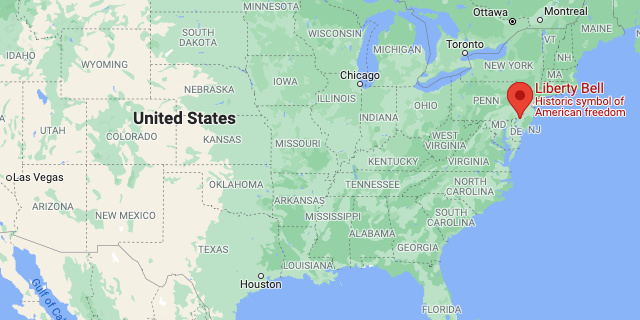
https://www.google.com/maps/place/Liberty+Bell
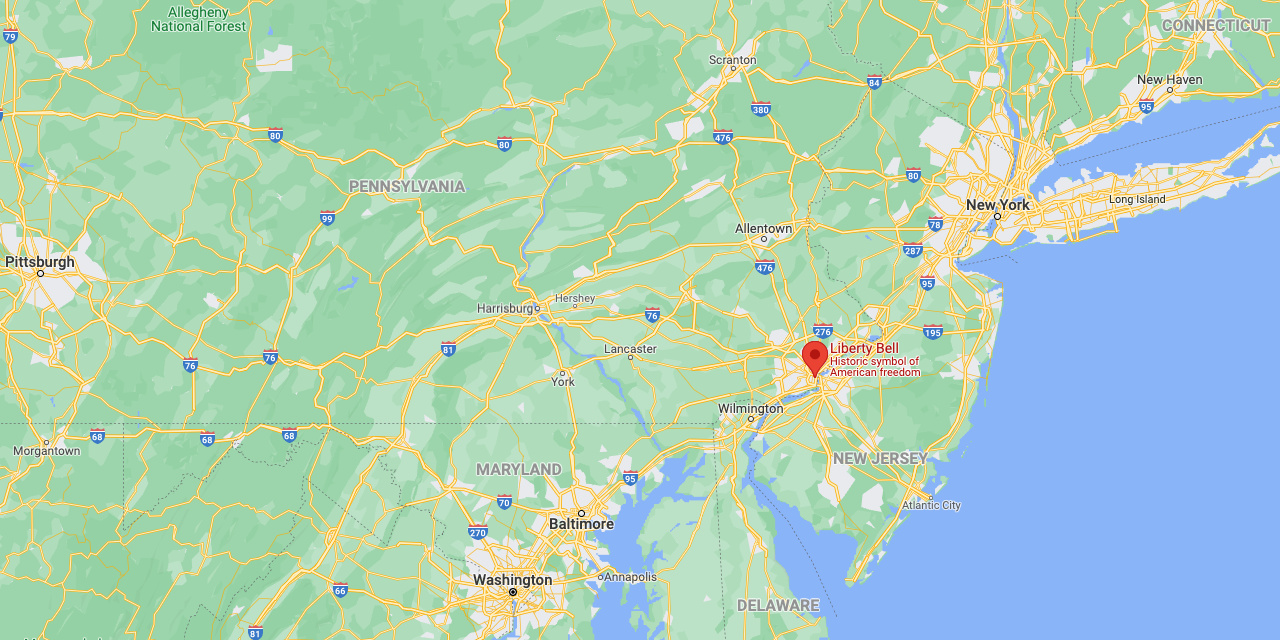
https://www.google.com/maps/place/Liberty+Bell
 From Signal to Symbol:
From Signal to Symbol:The State House bell, now known as the Liberty Bell, rang in the tower of the Pennsylvania State House. Today, we call that building Independence Hall. Speaker of the Pennsylvania Assembly Isaac Norris first ordered a bell for the bell tower in 1751 from the Whitechapel Foundry in London. That bell cracked on the first test ring. Local metalworkers John Pass and John Stow melted down that bell and cast a new one right here in Philadelphia. It's this bell that would ring to call lawmakers to their meetings and the townspeople together to hear the reading of the news. Benjamin Franklin wrote to Catherine Ray in 1755, "Adieu, the Bell rings, and I must go among the Grave ones and talk Politicks." It's not until the 1830's that the old State House bell would begin to take on significance as a symbol of liberty.
https://www.nps.gov/inde/learn/historyculture/stories-libertybell.htm
And ye shall hallow the fiftieth year, and proclaim liberty throughout all the land unto all the inhabitants thereof: it shall be a jubile unto you; and ye shall return every man unto his possession, and ye shall return every man unto his family.
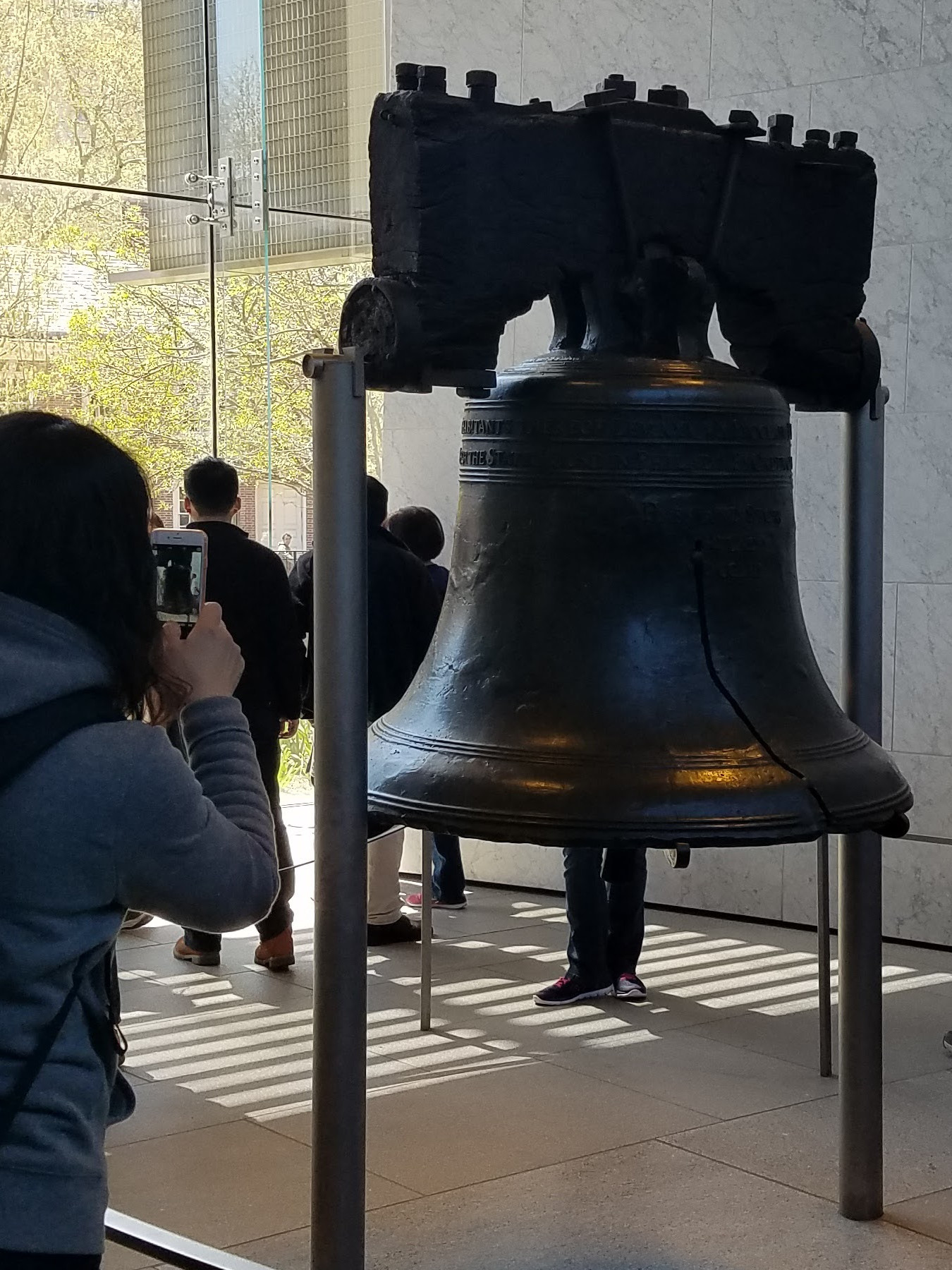
The Bell performed significant duties. The Bell summoned members of the Pennsylvania Assembly, like Benjamin Franklin, to meetings. It Joined a chorus of bells throughout the city that announced noteworthy events like the coronation of King George III. As discontent increased before the American Revolution, the Bell called citizens to protest Parliamentary "oppression."
Contrary to popular belief, there is no evidence that the Bell rang on July 4, 1776, to proclaim Independence. In fact, by 1776 the heavy Bell, swinging and vibrating with sound, threatened to topple the rotting State House steeple.
In 1777, Just before the British captured Philadelphla, patriots removed pubic and private valuables to safety, Including the State House Bell.
| Timeline |
|---|
| https://www.ushistory.org/libertybell/timeline.html |
| 1746: Construction on the state house is completed. This was Colonial America's grandest public building and would be home to the Liberty Bell. At this time, however, the building had no bell. |
| 1749: The Assembly, "Ordered, That the Superintendents of the State-House, proceed, ... to carry up a Building on the South-side of the said House to contain the Staircase, with a suitable Place thereon for hanging a Bell." |
| 1751: The Pennsylvania Assembly issued an order for the bell. |
| 1752: Isaac Norris, Assembly Speaker and the Chairman of the State House Superintendents asked the Assembly's agent in London, Robert Charles, to buy a bell. He wrote in his instructions: ISAAC NORRIS
The verse in Leviticus reads, in full, "And ye shall hallow the fiftieth year, and proclaim liberty throughout all the Land unto all the Inhabitants thereof."
Let the Bell be cast by the best Workmen & examined carefully before it is Shipped with the following words well shaped in large letters round in vizt. /By order of the Assembly of the Province of Pensylvania for the State house in the City of Philada 1752// //and Underneath//Proclaim Liberty thro' all the Land to all the Inhabitants thereof. Some historians believe that the inscription was meant as a commemoration and celebration of Penn's extraordinary 1701 Charter of Privileges, which put legislative power in the hands of the Assembly and took it from William Penn and the Proprietorship (those supporting the Penn family). So it would make good sense for the Assembly to pay homage to the rights granted fifty years earlier. Yet other historians pointedly note that Norris himself was known for his opposition to the Penn family (perhaps explaining why Pennsylvania is spelled "Pensylvania" on the bell). If the Bell were intended to celebrate the 50th anniversary why would it specify 1752, instead of 1751 which would have been the 50th anniversary? Perhaps, Norris recognizing that the Bell would not arrive until 1752 thought it would be curious to backdate his inscription. Or, perhaps, the fiftieth anniversary of the Charter was simply a coincidence. The historical record does not provide us an answer.Either way, agent Robert Charles ordered a bell from London's Whitechapel Foundry. The cost of the bell including insurance and shipping was 150 Pounds 13 shillings 8 pence. The Bell was sent from England on the ship Hibernia, captained by William Child. The Bell arrived. On September 1, 1752 Norris wrote the following to Assembly Representative Robert Charles: "The Bell is come ashore & in good order." He continued, "we have not yet try'd the sound." |
| March 1753: On March 10th Norris again wrote Agent Charles. ISAAC NORRIS
Norris went on to write that "two Ingenious Work-Men" had been hired to recast the bell. These workmen were named Pass and Stow and their names are today inscribed on the bell.
I gave Information that our Bell was generally like & appvd of but in a few days after my writing I had the Mortification to hear that it was cracked by a stroke of the clapper without any other violence as it was hung up to try the sound. |
| April 1753: After adding a dash more copper into the mixture of the Bell, the workmen were ready to try the new casting. It didn't sound good, apparently. Isaac Norris noted that "they were so teized (teased) by the witicisms of the Town that they...will be very soon ready to make a second essay." It seems they had added too much copper to the detriment of the tone of the bell. |
| June 1753: It was reported in the New York Mercury that "Last Week was raised and fix'd in the Statehouse Steeple, the new great Bell, cast here by Pass and Stow, weighing 2080 lbs. The steeple had been built in March of 1753 by Edmund Woolley, a member of Philadelphia's Carpenters' Company, and the master-builder who had overseen the construction of the State House. Pass and Stow charged slightly over 36 Pounds for their repair job. According to their bill, the Bell weighed 2,081 pounds. |
| November 1753: Not everyone was happy with the way the new Bell sounded, however, most significantly Isaac Norris. He wrote yet again to Robert Charles, "We got our Bell new cast here and it has been used some time but tho some are of opinion it will do I Own I do not like it." Norris suggested returning the metal from the Bell to England to be recast. |
| March 1754: Agent Robert Charles ordered a new bell from Whitechapel. |
| May 1754: The Assembly resolved to pay for the new bell while keeping the Pass and Stow bell. When the new bell arrived most folks agreed it sounded no better than Pass and Stow's recast Bell. The Pass and Stow Bell remained in the State House steeple. The new Whitechapel bell was hung in a cupola on the State House roof, attached to the State House clocks. It was this bell which rang the time for Philadelphians. The Pass and Stow bell rang for special events. |
| February 1757: It tolled for the meeting of the Assembly which would send Benjamin Franklin to England to address Colonial grievances. |
| March 1757: The Pennsylvania Gazette reported that the Bell was rung upon the arrival of Lord Loudon from New York. |
| February 1761: It tolled in honor of King George III ascending the throne. |
| 1761: The Assembly permitted nearby St. Paul's Church to use the bell to announce worship until their church building was completed and their own bell installed. |
| September 1764: It tolled upon the repeal of the Sugar Act. The Bell was rung to call the Assembly in which Benjamin Franklin was to be sent to England to address Colonial grievances. |
| October 1765: The Bell was "muffled" and rung when ships carrying tax stamps sailed up the Delaware River. The Bell was rung to summon citizens to a public meeting to discuss the Stamp Act. |
| April 1768: After the ringing of the Bell, merchants of Philadelphia held a gripe session condemning regressive Parliamentary measures which included a prohibition on the manufacture of steel in the Province of Pennsylvania as well as a ban on hat making. |
| September 1770: It tolled after a resolution claiming that Parliament's latest taxation schemes were subversive of Pennsylvanian's constitutional rights. |
| February 1771: It was rung to call the Assembly together to petition the King for a repeal of tea duties. |
| 1772: People living in the vicinity of State House petitioned the Assembly to stop ringing the bell so often, complaining that they were "incommoded and distressed" by the constant "ringing of the great Bell in the Steeple." |
| December 25, 1773: Shortly after the Boston Tea Party (12/16/1773), the Bell rung the news that the ship Polly was bringing "monopoly" tea into Philadelphia. At this time the Assembly resolved that Captain Ayres of the Polly would neither be allowed to land nor bring his tea to the custom house. |
| 1774: A muffled tolling announced the Intolerable Acts which included the closure of the Port of Boston. It tolled for a town meeting wherein the citizens of Philadelphia pledged over 4,000 pounds in aid for the suffering residents of Boston. |
| April 1775: It pealed to announce the Battle of Lexington and Concord. |
| July 4 1776: The Liberty Bell did not ring on July 4, 1776 for the Declaration of Independence. The reason? The Declaration is dated July 4, 1776, but on that day, the Declaration was sent to the printer. See July 8 1776. |
| July 8 1776: The first public reading of the Declaration of Independence. Bells tolled throughout the city on that day. Tradition holds that the Liberty Bell rang out this day. However, the steeple was in bad condition and historians today doubt the likelihood of the story. |
| September 1777: War came to the Philadelphia region. The British had won the Battle of Brandywine on September 11 and were poised to move into Philadelphia. Philadelphians tried to remove anything the British could make use of, including bells. Bells could be melted down and recast into cannon. On September 23, the State House Bell was taken down and shipped inland. A member of the Carpenters' Company was put in charge of the physical removal. The bell was hidden in the basement of the Zion Reformed Church in Allentown (where you can visit today). On its journey, the Bell was guarded by Colonel Thomas Polk of North Carolina who was in command of 200 North Carolina and Virginia militiaman. |
| June 27 1778: The Bell was brought back to Philadelphia but not rehung. The rotten steeple didn't allow it. The Bell was put into storage for seven years. Some believe the Bell was stored in one of the munitions sheds that flanked the State House. |
| 1781: The State House steeple was torn down. |
| 1785: The Bell was rehung in the rebuilt State House steeple. |
| 1787: The Bell was rung upon ratification of the Constitution. |
| 1789: It was rung throughout the year to call students of the University of Pennsylvania to classes at nearby Philosophical Hall. |
| 1790: Tolled at the death of Benjamin Franklin. |
| March 1797: Rung during the inauguration of John Adams. |
| December 1799: Tolled at the death of George Washington. |
| 1799: Pennsylvania's state capital moved to Lancaster. The Bell remained in Philadelphia and was used to call voters, to celebrate patriotic occasions, and to toll on the deaths of famous Americans. |
| July 1804: Tolled at the death of Alexander Hamilton. |
| 1816: The state of Pennsylvania announced its intention of selling the State House and yard. When it was learned that the yard was going to be subdivided for building lots, the city of Philadelphia was scandalized. It responded by purchasing the building and yard from the state for $70,000. |
| 1821: Philadelphia City Councils (there were two at the time) bought a new bell to be used for the clocks on the State House. The Liberty Bell would remain on the fourth floor of the brick part of the tower. |
| September 1824: Bell rung for Lafayette's triumphant return to Philadelphia. A letter to the Philadelphia Public Ledger on May 4, 1915 (nearly 100 years after the event) claimed that the Bell cracked on this occasion. There was no mention in the contemporary press that the bell cracked at that time, however. |
| July 1826: Tolled at the deaths of John Adams and Thomas Jefferson (both of whom died on July 4). |
| 1828: Philadelphia decided to reconstruct the State House steeple. Council also decided to replace the State House clock with a new one in the steeple. It was decided the new clock should have a new bell. A foundry owner named John Wilbank cast a 4,000 pound bell. In December, Wilbank's bell took the place of the old State House Bell, and the Liberty Bell was moved to a different part of the new tower. The bell that was installed as a clock bell in 1821 disappeared -- It's assumed that Wilbank took it as part of his payment. Wilbank was also supposed to haul away the Liberty Bell at that time. The city sued Wilbank for breach of contract -- because he did not take the Liberty Bell with him. Wilbank argued that draying (hauling) costs exceeded the $400 the Bell was assessed at. They haggled in court before a judge ordered a compromise: Wilbank would pay court costs; the City had to keep the Bell, which was technically considered "on loan" from Wilbank. Over the years, Wilbank's heirs have agitated the city of Philadelphia to give them the Bell which they considered rightfully theirs. In a 1915 agreement, the family agreed to keep the bell on loan as long as it hung in Independence Hall. In 1984, an heir of Wilbank named James McCloskey claimed the Bell for himself, noting that it had moved to a pavilion a block north of Independence Hall. He claimed that he wanted to display it in his hometown of Baltimore, or barring that, melt the Bell down "and make seven million rings -- all cracked -- and sell them for $39.95 each."Rung to celebrate the Catholic Emancipation Act. A newspaper article from 1914 claims the Bell cracked on this occasion. Again, the story was written nearly 100 years after the event. There was no mention in the contemporary press that the bell cracked at that time, however. |
| 1831: City Councils agree to let the youths of the city ring "the old State House Bell" on July 4th. |
| February 1832: Rang for the Centennial birthday celebration for George Washington. |
| July 1834: Tolled at the death of the Marquis de Lafayette |
| 1835: In an interview in the Sunday New York Times of July 16, 1911, one Emmanuel Rauch claims that when he was a boy of 10, he was walking through the State House Square on Washington's Birthday when the steeple-keeper, Major Jack Downing, called him over. Rauch, along with several other boys were asked whether they wanted to ring the Bell in honor of Washington's Birthday. The boys started the ringing, and after the clapper had struck about a dozen times, both the lads and Major Downing noticed a change in the Bell's tone. Upon examining the Bell, they discovered a hairline crack, over a foot long. Major Downing sent the boys on their way. |
| July 8, 1835: Long-believed to have cracked while tolling for John Marshall, who had died while in Philadelphia. However, this is historically questionable. |
| 1837: The Bell was used as a frontispiece to an 1837 edition of Liberty, published by the New York Anti-Slavery Society. |
| 1839: William Lloyd Garrison's anti-slavery publication The Liberator reprinted a Boston abolitionist pamphlet containing a poem about the Bell, entitled, The Liberty Bell, which represents the first documented use of the name, "Liberty Bell." |
| April 1841: Muffled and rung upon the death of William Henry Harrison. |
| February 1846: The most famous crack in history, the zig-zag fracture occurs while the Liberty Bell is being rung for Washington's birthday. The Philadelphia Public Ledger takes up the story in its February 26, 1846 publication: The old Independence Bell rang its last clear note on Monday last in honor of the birthday of Washington and now hangs in the great city steeple irreparably cracked and dumb. It had been cracked before but was set in order of that day by having the edges of the fracture filed so as not to vibrate against each other ... It gave out clear notes and loud, and appeared to be in excellent condition until noon, when it received a sort of compound fracture in a zig-zag direction through one of its sides which put it completely out of tune and left it a mere wreck of what it was. |
| 1852: The Bell was brought down from the steeple and placed in "Declaration Chamber" of Independence Hall. |
| 1876: Displayed at the Centennial Exposition in Philadelphia |
| 1885: Bell traveled by train to New Orleans for a World Industrial and Cotton Exposition and to help foster national unity. |
| 1893: Bell traveled to Chicago for World's Fair. |
| 1895: Bell traveled to Atlanta for the Cotton States and Atlantic Exposition Exposition. |
| 1902: Bell traveled to Charleston for the Interstate and West Indian Exposition. A widely circulated story holds that it was involved in a train wreck, but evidence has surfaced revealing this rumor to be incorrect. |
| 1903: Bell traveled to Boston to take part in a celebration of the Battle of Bunker Hill. |
| 1904: Bell traveled to Saint Louis for the Louisiana Purchase Exposition. |
| 1908: Procession through the streets of Philadelphia to celebrate Founders Week. |
| February 11, 1915: The Liberty Bell was recorded. I, accompanied by Raymond Sooy and Marcus Olsen, two members of the Recording Department. took a recording equipment to Independence Hall, Philadelphia, and made a record of the Taps of the Liberty Bell (tapping being done by Mayor Smith of Philadelphia) which were transmitted by wire to San Francisco, Cal., as the official opening signal of the Pan American Exposition. Don't ask me whether or not the liberty Bell sounds like a bell, because I shall tell you 'It does not.' 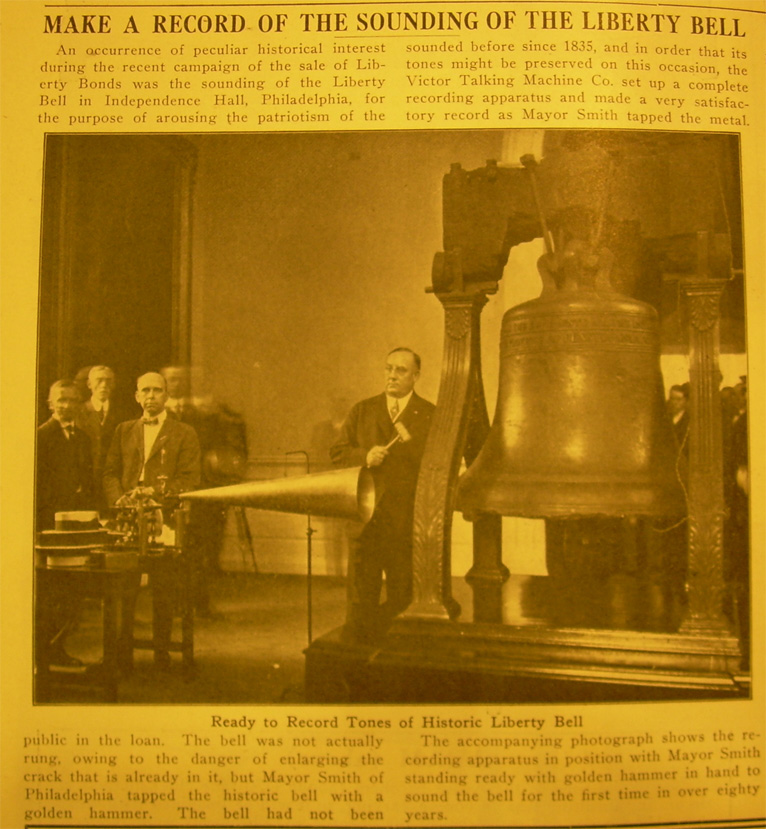
|
| 1915: Bell traveled to San Francisco for the Panama-Pacific Exposition In 1915, 500,000 schoolchildren signed a petition asking the city of Philadelphia to send the Liberty Bell to the Panama-Pacific International Exposition of San Francisco. Philadelphia complied, and so the world's most famous symbol of liberty began its one and only tour of the nation. The Liberty Bell travel cross country by train. The train made frequent stops to large, enthusiastic crowds as it made its way to San Francisco. City officials were initially reluctant to send the Bell on this trip because they thought all the recent traveling and handling had damaged the Bell. Newspaper editorials across the country weighed in on the pros and cons about moving the Bell. Ultimately a petition signed by several hundred thousand school children helped sway Philadelphia officials to allow the Bell to travel. The Bell traveled over 10,000 miles on the San Francisco trip, stopping in many towns and cities along the way. Vibrant, patriotic crowds greeted the Bell waving flags, blowing whistles, with brass bands, and gun salutes. Enthusiastic Philadelphians welcomed the Bell back upon its return to Philadelphia. It was the Bell's final rail journey. |
| 1915: Justice Bell (today at the Washington Memorial Chapel, Valley Forge) is a 2000-pound replica of the Liberty Bell, forged in 1915 to promote women's suffrage. It traveled the country with its clapper chained to its side, silent until women won the right to vote. On September 25, 1920, it was brought to Independence Hall and rung in ceremonies celebrating the ratification of the 19th amendment. |
| 1917: Mounted on a truck and driven through the streets of Philadelphia for a WWI Liberty Bond sale. |
| December 31 1926: To help celebrate the 150th anniversary of Independence, it was decided that the Liberty Bell should help usher in the New Year with a ceremonial tap. Microphones were placed round the Bell, and at midnight it was struck with a specially designed mallet by the mayor's wife. |
| June 1944: D-Day: The Bell tapped with rubber mallet twelve times by Philadelphia Mayor Bernard Samuel during a national radio program to symbolize "Independence." At the show's end the Bell was tapped seven times to symbolize "Liberty." |
| August 1962: Tapped on the first anniversary of the Berlin Wall to show solidarity with East Germans. |
| 1976: 12:01 A.M. To help celebrate America's Bicentennial, the Liberty Bell was moved from Independence Hall to a pavilion across the street on Independence Mall. The Pavilion which allows visitors to view the Bell at any time during the day was designed by Mitchell/Giurgola and Associates. |
| 1997: The National Park Service instituted a "fee demonstration program" at three less-visited locations in Philadelphia. It is speculated by people in the know that the ultimate plan is to impose visitor fees at the Liberty Bell and Independence Hall. Plans are considered for development of the mall area, which includes moving the Liberty Bell closer to Independence Hall. |
| April 6 2001: Tourist attacks Liberty Bell with hammer. The incident took place around 9:30 a.m. just as a group was finishing a Liberty Bell tour. Sheridan said rangers heard the sound of metal striking metal and the "next thing they knew they turned around and saw an individual standing behind the bell," on the side that faces Independence Hall, striking it with a hammer four or five times. "A ranger tackled him, called law enforcement and we took him into custody," Sheridan said. As he was being led away, other tourists said, the suspect, who was said to be wearing his hair in stringy dreadlocks, cried out, "I didn't do anything violent." |
| March 24 2002: The new Liberty Bell Center comes under a blistering attack when it is revealed that the President's House in Philadelphia, used by Washington and Adams from 1790-1800, had slave quarters right where the entrance to the new Liberty Bell Center would be in the redesign. |
| May 13 2002: Historians meet to discuss the proposed Liberty Bell Center, the President's House, and the issue of slavery at the site. |
| January 15 2003: The Park Service held a public meeting to unveil the preliminary site design for its treatment of the President's House, adjoining the Liberty Bell center, in Philadelphia. |
| February 15 2003: About 10,000 people (according to the Philadelphia police) participated in an Anti-war rally at the Liberty Bell. |
| October 9 2003: The new Liberty Bell Center, costing $12.6 million, is opened to the public. |
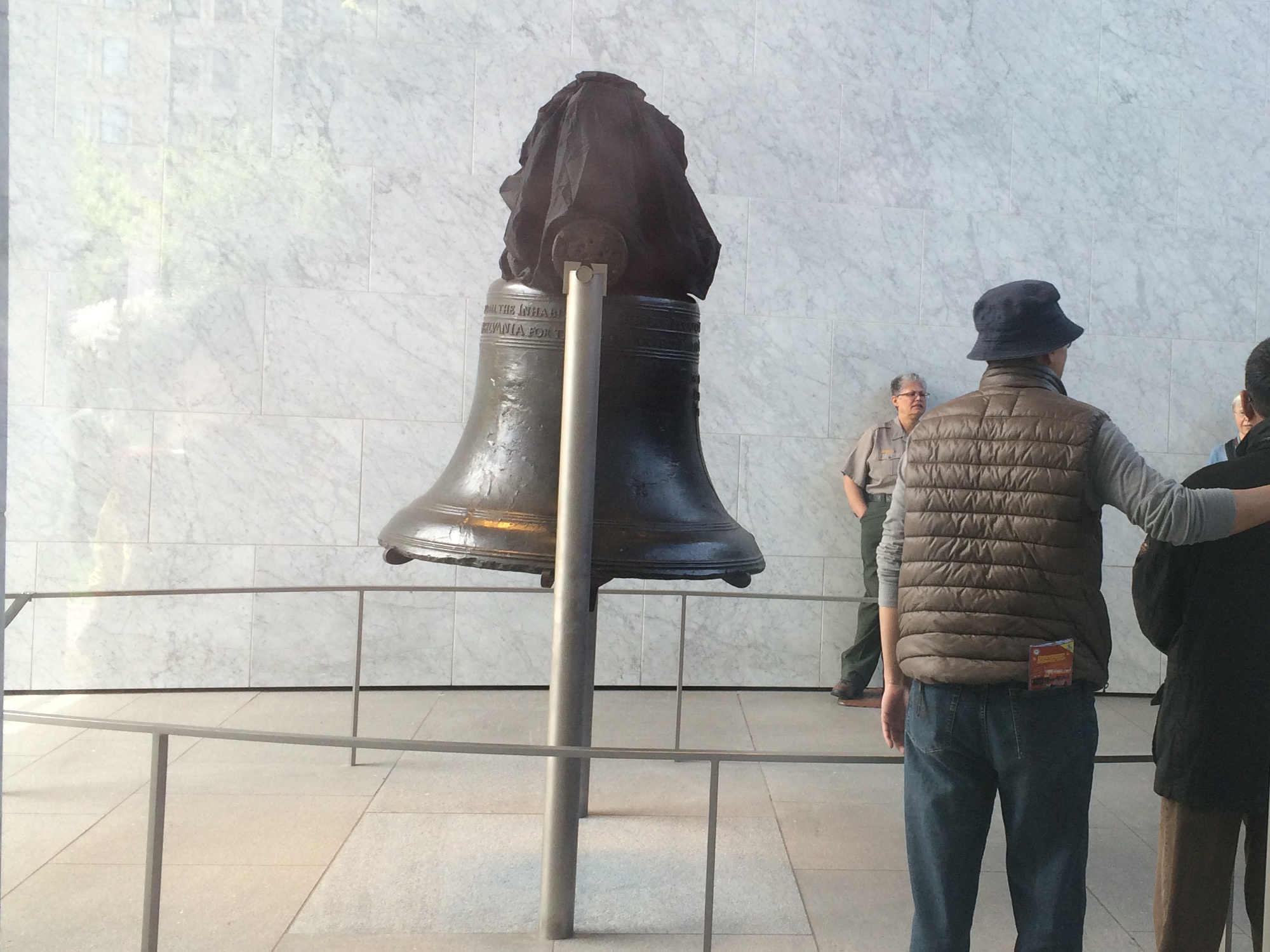
The Liberty Bell still hangs from its original yoke. The yoke was made from slippery elm, which is also known as American elm.
Popularly known as "Ring, Grandfather, Ring"
Adapted from Legends of the American Revolution, 1847
by George Lippard
And the child raised itself on tip-toe and pressed its tiny hands against the bell, and read, in lisping tones, "Proclaim Liberty to all the Land and all the inhabitants thereof."
The old man ponders for a moment on those strange words; then gathering the boy in his arms he speaks, "Look here, my child? Wilt do the old man a kindness? Then haste you down stairs, and wait in the hall by the big door, until a man with a velvet dress and a kind face will come out from the big door, and give you a word for me. When he gives you that word, then run out yonder in the street, and shout it up to me.
The boy with blue eyes and flaxen hair sprang from the old Bell-keeper's arms, and threaded his way down the dark stairs.
Under that very bell, pealing out at noonday, in an old hall, 56 traders, farmers and mechanics had assembled to shake the shackles of the world. Look over the faces of these 56 men and see every eye turned to the door. There is silence in this hall - every voice is hushed - every face is stamped with a deep and awful responsibility. Why turns every glance to that door? ... The Committee of Three, who have been out all night, penning a parchment are about to appear. The parchment, with signatures of these men, written with the pen lying on yonder table will either make a world free - or stretch these necks upon the gibbet. The door opens - the Committee appear. The three advance to the table. The Parchment is laid there. Shall it be signed or not?
Look! How they rush forward. ... Look how the names blaze on the Parchment. ... And now the Parchment is signed; and now let word ... go out to all the earth. ... Let the Bell speak out the great truth!
Meanwhile, the old man waited. "Oh," groaned the old man, "he has forgotten me! These old limbs will have to totter down the State House stairs, and climb up again-"
As the word was on his lips, a merry, ringing laugh broke on the ear. There, among the crowds on the pavement, stood the blue-eyed boy, clapping his tiny hands. And then, swelling his little chest, he raised himself on tip-toe, and shouted a single word, "Ring!"
Do you see that old man's eye fire? Do you see that arm so suddenly bared to the shoulder, do you see that withered hand. grasping the Iron Tongue of the Bell? The old man is young again; his veins are filled with new life. Backward and forward, with sturdy strokes, he swings the Tongue. The bell speaks out! The crowd in the street hear it, and burst forth in one long shout! The city hears it, and starts up from desk and work-bench, as though an earthquake had spoken! Yes, as the old man swung the Iron Tongue, the Bell spoke to all the world. That sound crossed the Atlantic - pierced the dungeons of Europe - the work shops of England - the vassal-fields of France!
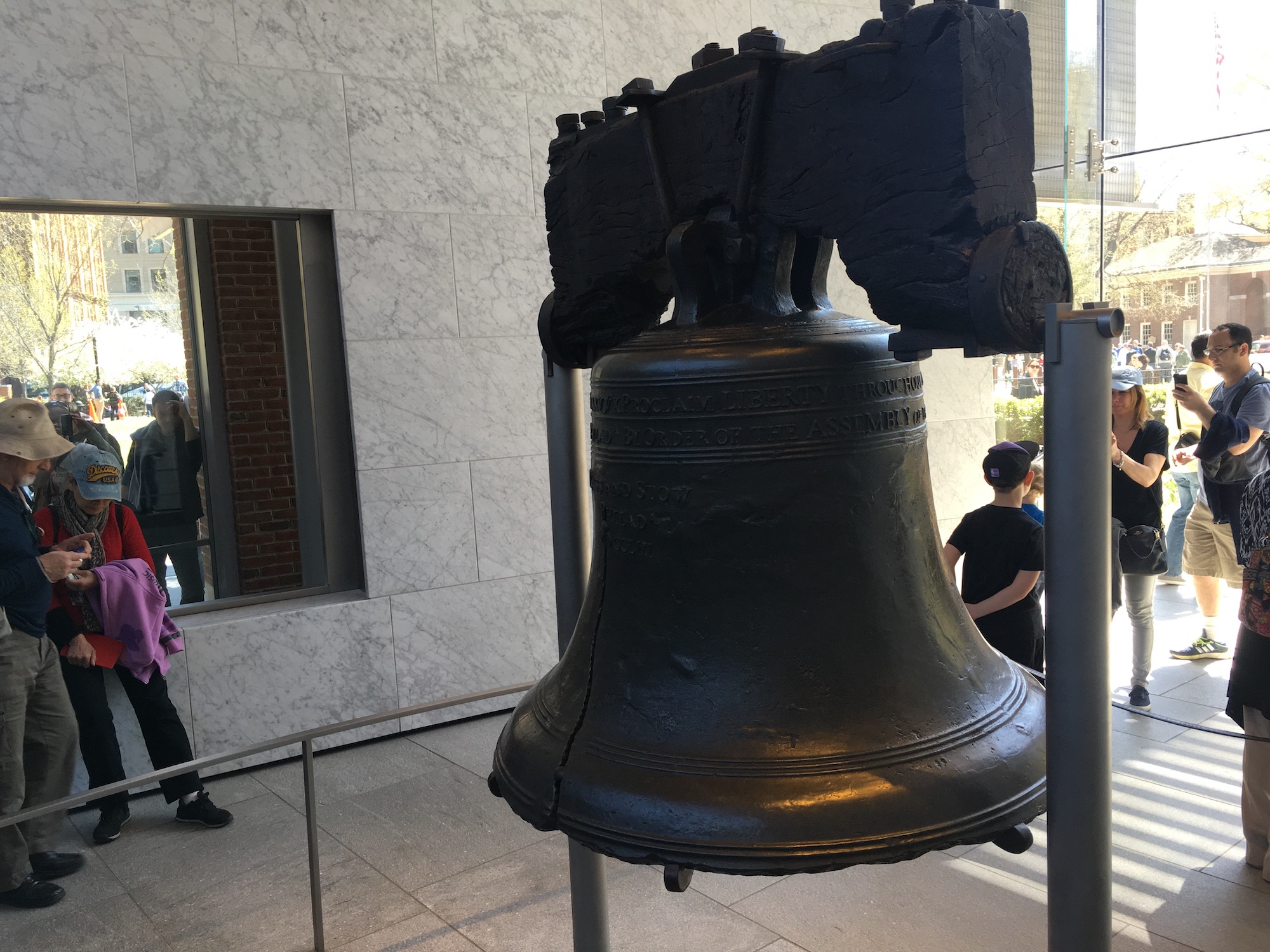
- The Liberty Bell weighs 2,080 pounds. The yoke weighs about 100 pounds.
- From lip to crown, the Bell measures three feet. The circumference around the crown measures six feet, 11 inches and the circumference around the lip measures 12 feet.
- The Liberty Bell is composed of approximately 70 percent copper, 25 percent tin and traces of lead, zinc, arsenic, gold and silver. The Bell is suspended from what is believed to be its original yoke, made of American elm.
- The cost of the original bell, including insurance and shipping was £150, 13 shillings and eight pence ($225.50) in 1752. The recasting cost slightly more than £36 ($54) in 1753.
- In 1876, the United States celebrated the Centennial in Philadelphia with a display of replica Liberty Bells from each state. Pennsylvania's display bell was made out of sugar.
- On the Liberty Bell, Pennsylvania is misspelled "Pensylvania." This spelling was one of several acceptable spellings of the name at that time.
- The strike note of the Bell is E-flat.
- The federal government gave every state and its territories a replica of the Liberty Bell in the 1950s as part of a national U.S. Savings Bond campaign.
- The Bell has had three homes: Independence Hall (the Pennsylvania State House) from 1753 to 1976, the Liberty Bell Pavilion from 1976 to 2003 and the new Liberty Bell Center beginning on October 9, 2003.
- Each year, more than a million people visit the Liberty Bell.
- Visitor records were broken in 1976, when 3.2 million people visited the Liberty Bell in its new home for the Bicentennial.
- Forty million people have visited the Bell in the Liberty Bell Pavilion, built for the Bicentennial celebration.
- The Liberty Bell Center is open year-round (including all major holidays) from 9 a.m. to 5 p.m., and is located on Market Street, between 5th and 6th Streets.
https://www.nsf.gov/news/special_reports/liberty/01_history_04.jsp

Out in front of the Liberty Bell Center. Behind that glass wall is the Liberty Bell.
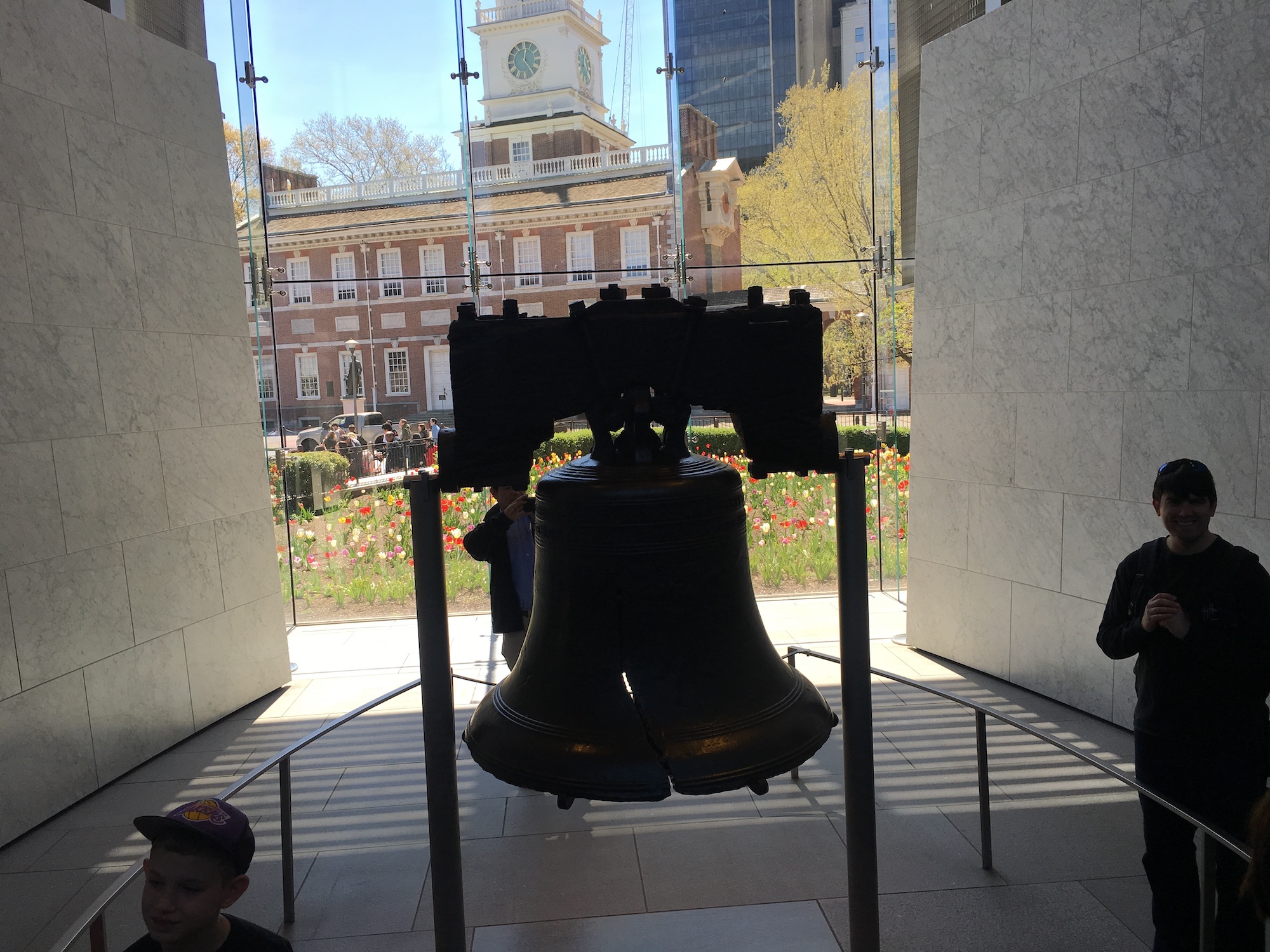
You can see Independence Hall in the background (where the Declaration of Independence & the U.S. Constitution were debated & signed)
The Liberty Bell's famous gap - often called a crack and running from lip toward crown - makes it Instantly recognizable.
That gap is really the result of an attempt to fix a thin crack that destroyed the Bell's tone at some moment after the American Revolution.
Exactly when that crack developed is lost to history. The repair work dates to 1846. It failed when, as the Bell rang for George Washington's birthday anniversary, the original crack reappeared and lengthened. It zigzagged up toward the top of the Bell, silencing it - at least physically - forever.
 The Original Crack:
The Original Crack:Chalk the Philly landmark's famous blemish up to faulty building materials from across the pond. In 1751, the Pennsylvania Provincial Assembly shelled out 100 pounds to London's Whitechapel Bell Foundry for a bell to hang in the State House (known post-Revolution as Independence Hall). The Whitechapel Bell Foundry — famous for casting Big Ben a century later and listed in the Guinness Book of World Records as Great Britain's oldest manufacturing company — dropped the ball on the bell, casting it with too-brittle metals.
When the bell arrived in Philadelphia in 1752, it cracked on its first test strike. Two local craftsmen, John Pass and John Stow, twice cast a new bell using metal from the cracked English bell. They also added more copper, to make the bell less brittle, and silver, to sweeten its tone. The recast behemoth weighed in at 2,000 pounds: 70 percent copper, 25 percent tin, and a scattering of lead, zinc, gold, silver, and arsenic.
https://www.mentalfloss.com/article/51529/how-did-liberty-bell-get-cracked
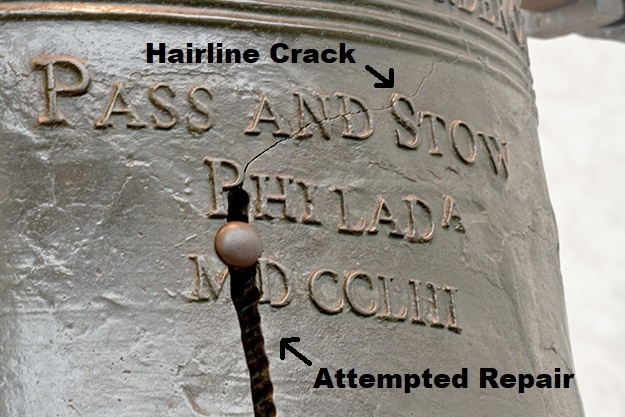
The Liberty Bell's first crack, the one that required Pass and Stow to recast the bell, would unfortunately not be the bell's last crack. However, unlike the first cracking of the Liberty Bell, there is much less information about the second crack. It is unclear when the second crack even occurred, much less what caused it. What is certain is that after cracking again, there was an attempt to repair the cracked bell. We also know that the repaired Liberty Bell was rung in celebration of George Washington's birthday in 1846, and that the repairs failed again on that day. The crack greatly extended to the crown of the bell, placing the bell beyond repair and forever silencing the Liberty Bell.
The big gash you see was an intentional repair:
When viewing the Liberty Bell, most people think the location of the bell's crack is obvious.
However, what most people believe is the Liberty Bell's crack is in fact the attempted repair of the bell.
If you look closely at the giant gash that runs down the Liberty Bell, you will notice that this is no natural crack, and you will see clear markings that were machine made.
In an attempted repair, a drill was used to separate the two sides of the cracked Liberty Bell to prevent the two sides from rubbing together when rung, because they believed that continued friction would further damage the bell.
The hairline crack is the problem:
If you want to see the actual crack that silenced the Liberty Bell you have to look very closely.
Follow the big man-made gap up to its end point, right between the "P" and "H" in "Philad".
From there, if you are really standing close to the Liberty Bell, you will be able to see a very small hairline fracture that extends diagonally to the right, all the way up to the top of the Liberty Bell where it happens to intersect directly through the word "Liberty".
This hairline fracture is the crack that silenced the Liberty Bell on George Washington's Birthday in 1846.
https://www.theconstitutional.com/blog/2018/07/09/liberty-bell-history
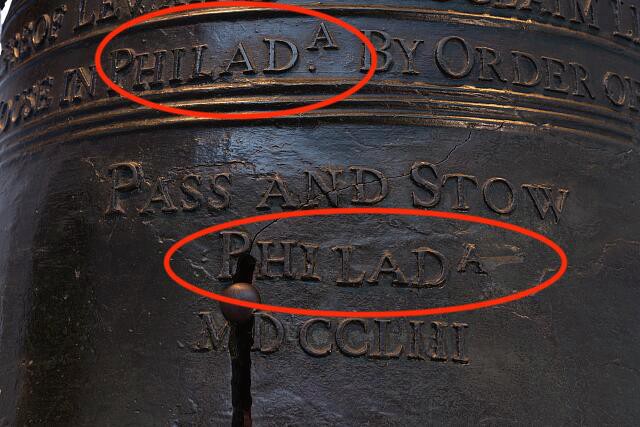
It's an abbreviation even older than "Philly"
It was used in the 17th and 18th centuries as "an archaic abbreviation for the modern city of Philadelphia," says abbreviations.com. More recently, it says, ‘Philly' is the common reference.
Philada shows up on a whole variety of items: military patches, pharmaceutical bottles manufactured in Philadelphia, mineral water bottles, paintings, Civil War tokens, clocks and medallions. There's even a 26-foot multi-media law library in the Philadelphia Criminal Justice Center titled "Philada Book of Just Hours" ... created in 1995.
Philada Fast Facts:
- 1751: The year the Liberty Bell, was ordered from London's Whitechapel Bell Foundry. "Philada" appears twice on it.
- 1858: The year a popular ferry named Philly began operating in the Delaware River between Camden and Philadelphia.
- 1900: First year the Social Security Administration recorded the name "Philada" on a birth.
https://southwarkhistory.org/what-you-probably-never-noticed-on-the-liberty-bell
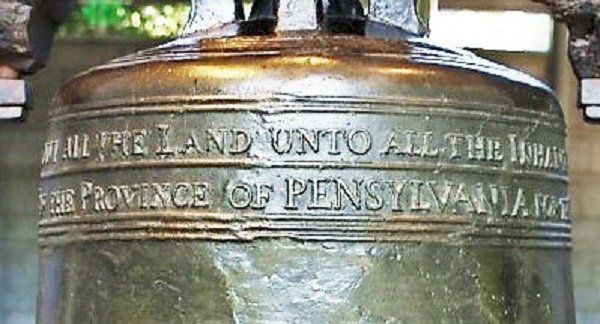
Yes, but not because they were illiterate.
The inscription of the Liberty Bell states:
By Order of the ASSEMBLY of the Province of PENSYLVANIA for the State House in PhiladA
Pass and Stow
Philada
MDCCLIII
At the time, "Pensylvania" was an accepted alternative spelling for "Pennsylvania." That same spelling was used by Alexander Hamilton, in 1787 on the signature page of the Constitution of the United States.
So it was an acceptable alternate that over time was diminished out of the English American Lexicon.
https://www.quora.com/Is-It-True-That-The-word-Pennsylvania-is-misspelled-on-the-Liberty-Bell
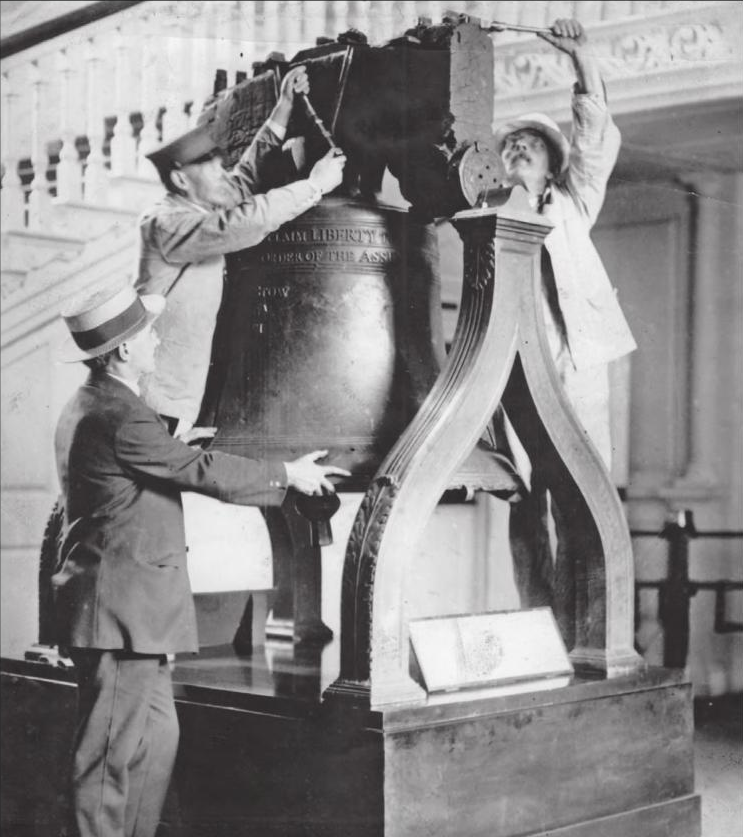
The Yoke:
The yoke is made from American elm, also known as slippery elm, and is believe to be the original wood. The yoke weighs 200 pounds; this is about one-tenth the weight of the Liberty Bell itself. (INHP.)
https://books.google.com/books?id=vjABPhVwE0EC&pg=PA66&lpg=PA66&dq=liberty+bell+yoke+reinforcement
In 1962, the National Park Service invited the Franklin Institute of Philadelphia to conduct a study of the Liberty Bell and the wood yoke that bears the bell's weight. In response, the Committee for the Preservation of the Liberty Bell was established. It was hoped that the research would reveal the crack's extent and how to prevent further cracking in the future and whether the wood yoke needed replacing or strengthening. (INHP.)
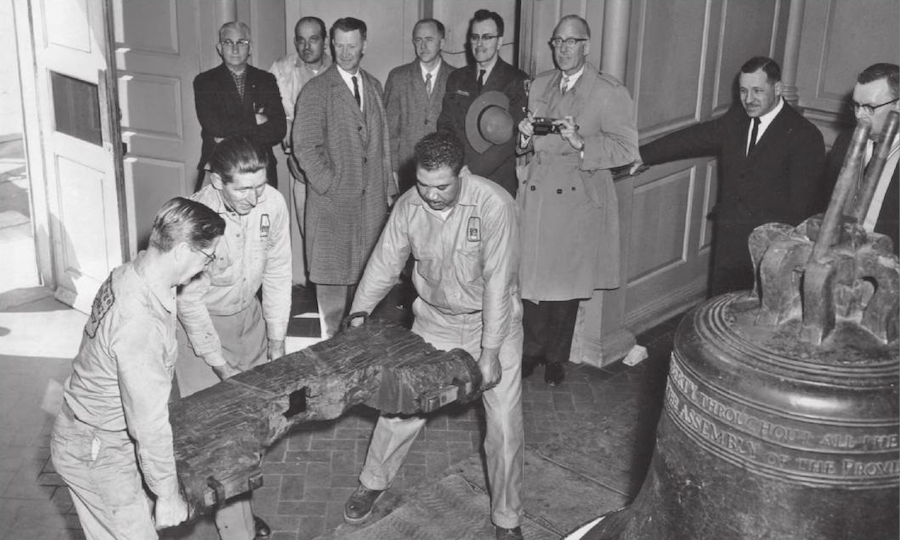
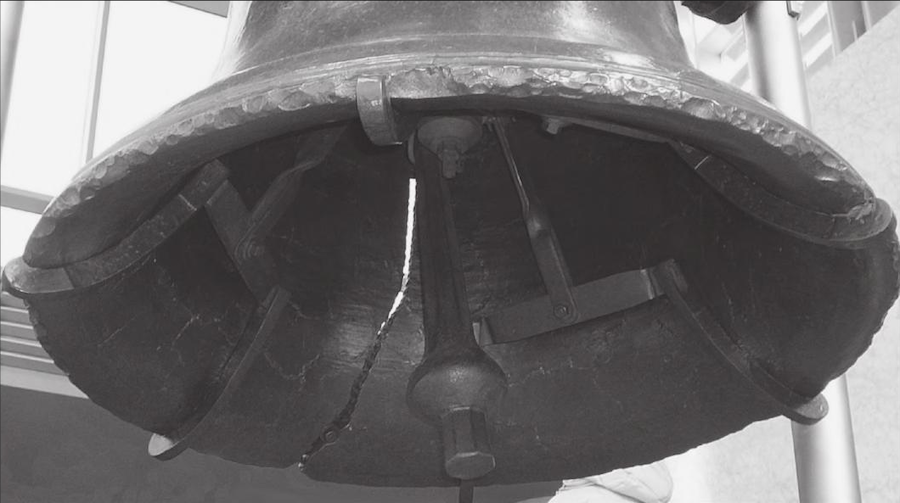
Hidden beneath the Liberty Bell is an interesting piece of framework. Devised by J. Sellers Bancroft, the metal structure placed inside the bell is called the spider. Its purpose is to hold the bell's weight to prevent any further cracking. The spider was attached in May 1915 in preparation for the bell's long westward journey to San Francisco. Many felt that the long trip would be detrimental to its safety. (CA.)
https://books.google.com/books?id=vjABPhVwE0EC&pg=PA66&lpg=PA66&dq=liberty+bell+yoke+reinforcement
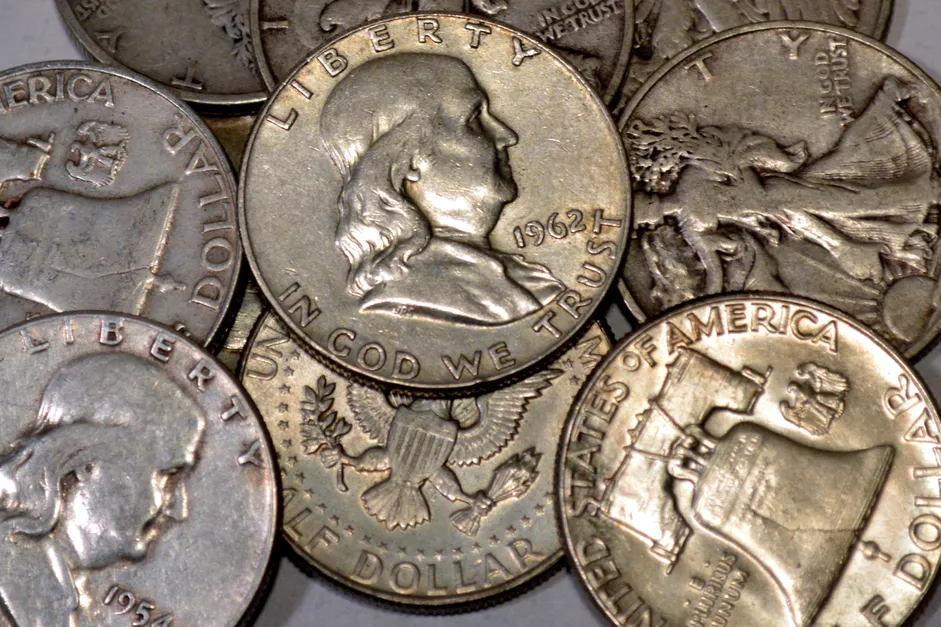
In 1948 Chief Engraver for The United States Mint, John R. Sinnock sculpted the design for the Franklin half dollar based upon a bust statue of Benjamin Franklin created by Jean Antoine Houdon. The reverse features a large rendition of the Liberty Bell. The United States Mint produced Franklin half dollars from 1948 through 1963.
Franklin half dollars are made of 90% silver and have approximately 0.3617 troy ounces of pure silver in them. Depending on the current price of silver, the coin could be worth more because of its silver content than its value to a coin collector. The value of a coin that is solely based on its metallic content is known as the intrinsic metal value (or bullion value) of the coin.
https://www.thesprucecrafts.com/franklin-half-dollar-values-4034072
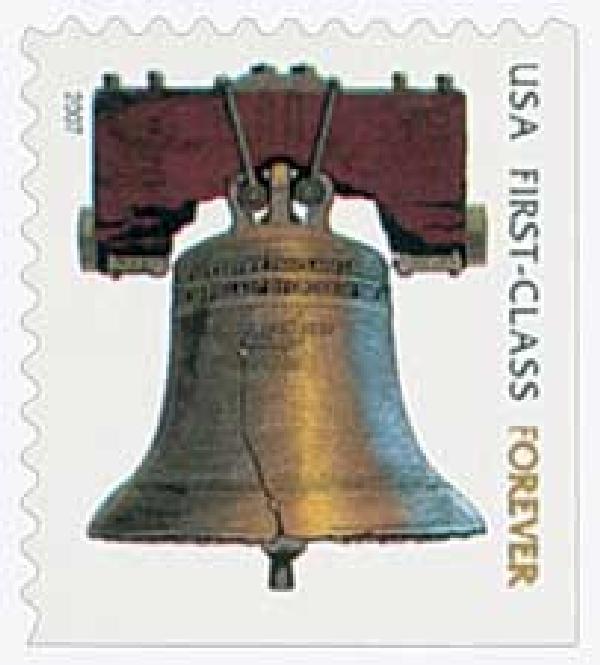
Liberty Bell Forever Stamp:
On April 12, 2007, the USPS issued its first Forever stamp, which featured a patriotic image of the Liberty Bell.
As postal costs increased, the USPS began to increase their rates for the various classes of mail. Before becoming effective however, these rate increases had to be submitted to the Postal Rate Commission (PRC) for approval. Often, the PRC would take as much as a year conducting studies and compiling data before accepting or rejecting the changes. If the rate increase was approved, the postal service then had to rush to design and produce the new stamps.
In 2006, the USPS requested permission to create a new type of non-denominated stamp, similar to what the United Kingdom had done. The UK had begun producing stamps with "1st" and "2nd" (as in classes of mail), rather than denominations. These new "Forever" stamps, as they called them, would be valid for first-class postage. Customers would be able to purchase Forever stamps at the current first-class postage rate and use them anytime in the future, regardless of rate increases. It would prevent the need for rate-change stamps, making things easier for both the USPS and mailers.
The first Forever stamp was unveiled to the public on March 26, 2007. And it went on sale shortly thereafter, on April 12, 2007. The First Day ceremony was held in Philadelphia, Pennsylvania, which was fitting since the stamp pictured the Liberty Bell.
For several years, the Liberty Bell was the only Forever stamp, and other stamps of the time were issued with the current denominations.
In 2010, the USPS released a new Forever stamp, picturing pinecones on evergreen trees.
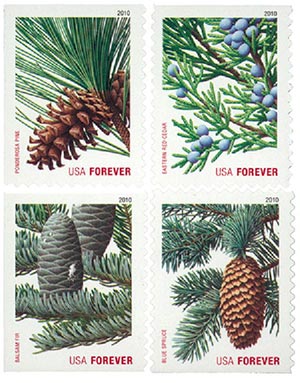
And two months later, they issued the Lady Liberty and Flag Forever stamps.
https://www.mysticstamp.com/Products/United-States/4125_4437/USA
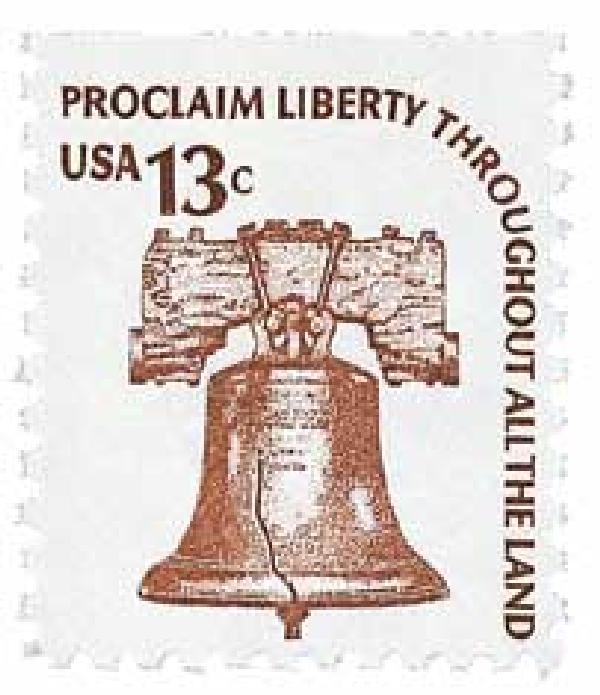
1975 13c Americana Series: Liberty Bell:
In 1971, the USPS hired a private firm to develop a concept for a new series of definitive stamps. The resulting set, the Americana Series, would include over 20 different designs printed in sheet, coil, and booklet format.
The Americana stamps followed a very uniform plan that outlined the designs of individual stamps as well as the blocks of four. In all, there were five different blocks, each with a different theme, but similar design style – the subject in the center, and the title curving around two of the edges. When all four stamps were placed together, the titles created a frame around the stamps. The five themes were Roots of Democracy, Rights and Freedoms of the American People, Symbols of America, Pioneer America, and America's Light.
The first stamp in the series, #1595, pictured the Liberty Bell and was issued on October 31, 1975.
There are several varieties of many of the stamps in the series.
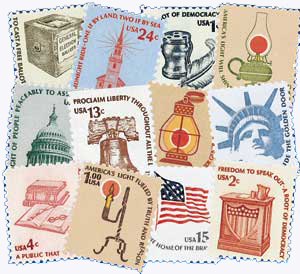
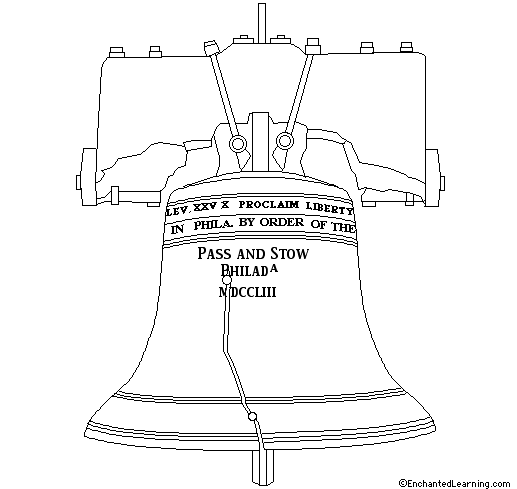
- Across the top of the bell is the inscription, "PROCLAIM LIBERTY THROUGHOUT ALL THE LAND UNTO ALL THE INHABITANTS THEREOF LEV. XXV X." This is a quote from the Old Testamentent of the Bible, Leviticus chapter 25, verse 10.
- Under this reads, "BY ORDER OF THE ASSEMBLY OF THE PROVINCE OF PENSYLVANIA [sic] FOR THE STATE HOUSE IN PHILADA."
- Lower on the bell are the inscriptions, "PASS AND STOW," the last names of the founders who cast the bell (John Pass and John Stow).
- Beneath this is "PHILADA," short for Philadelphia.
- The lowest inscription is the Roman numerals MDCCLIII (1753), the year the bell was re-cast.
https://www.enchantedlearning.com/history/us/monuments/libertybell/printout.shtml
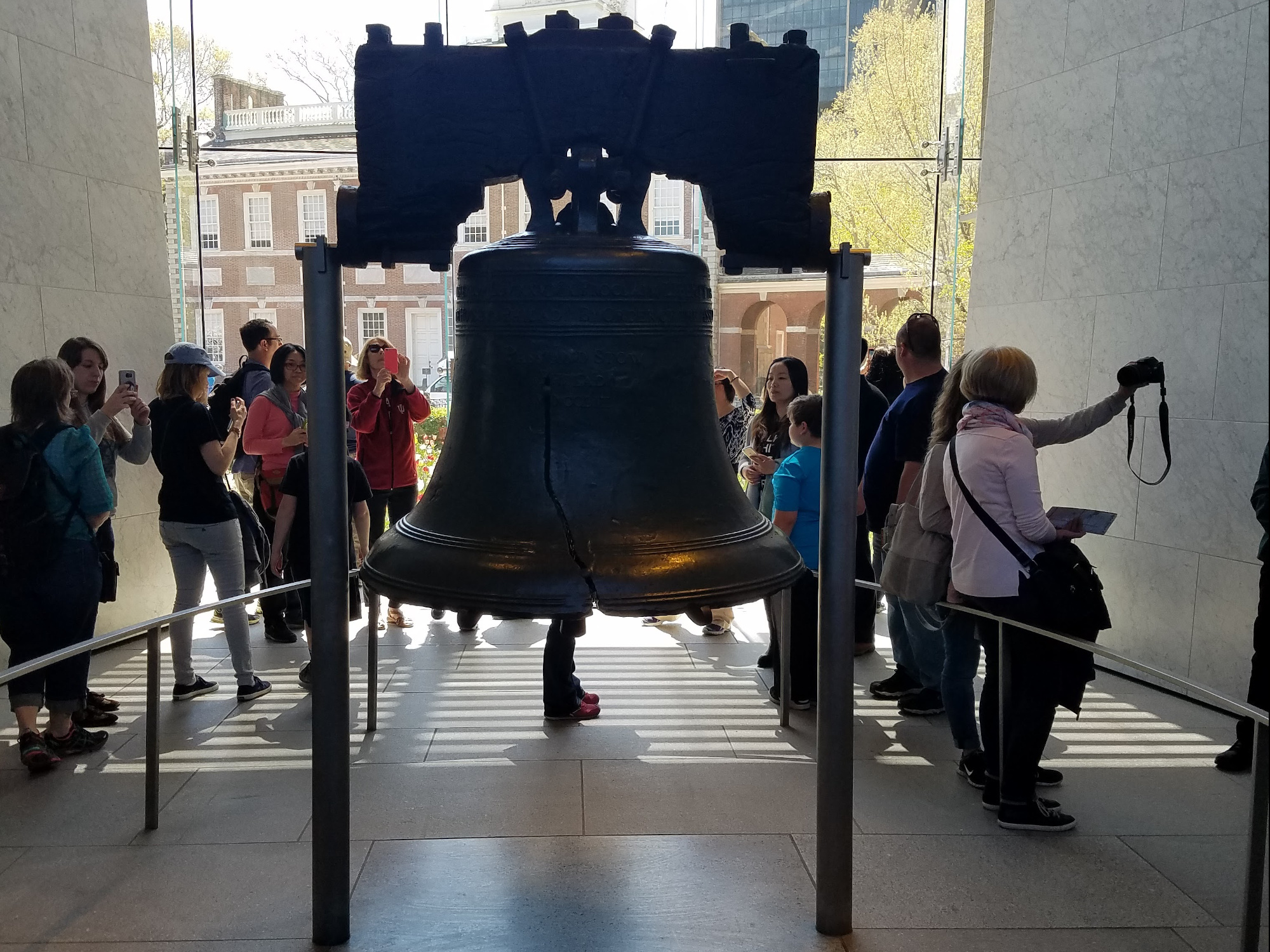
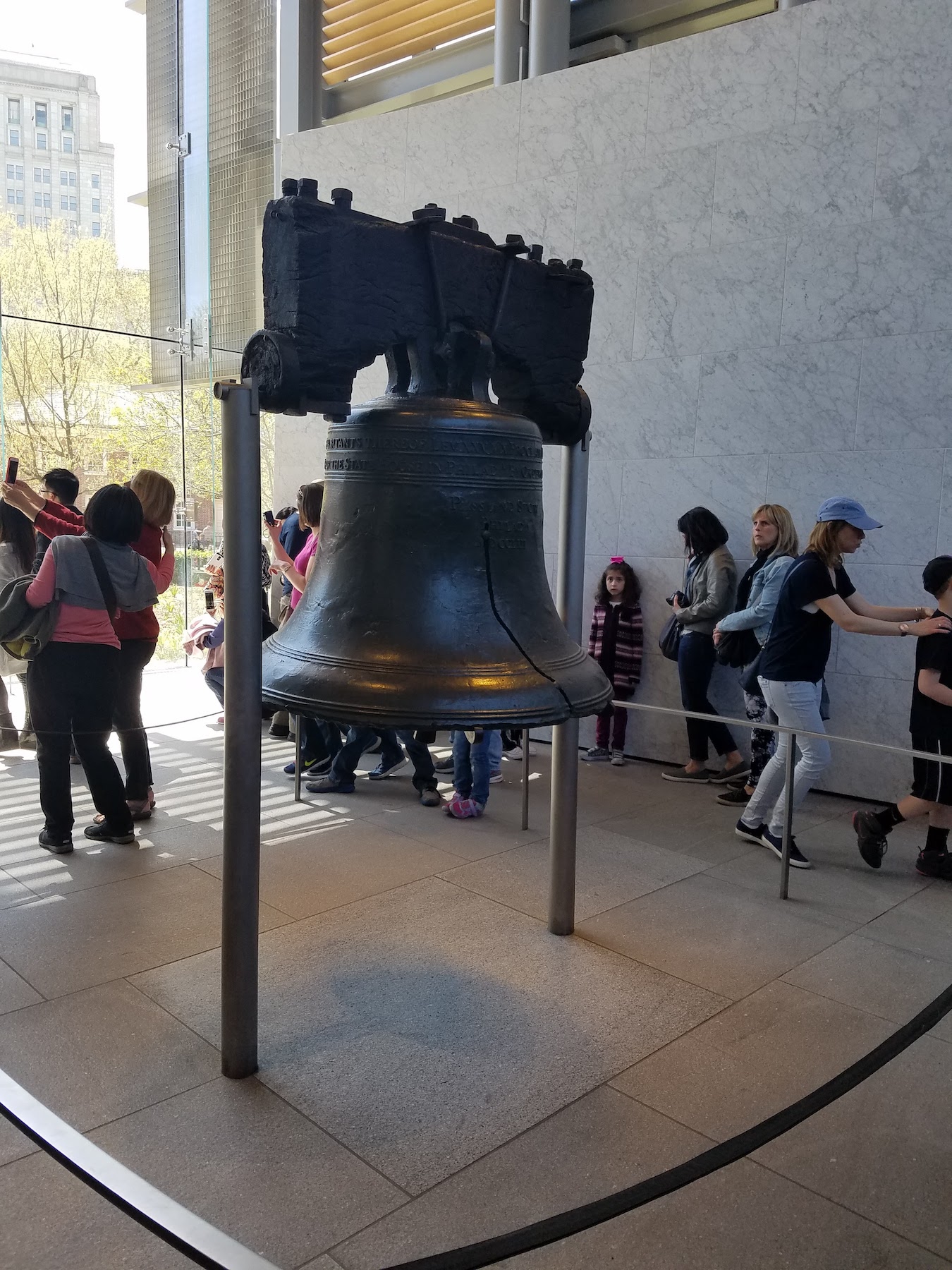

The Sound of L-I-B-E-R-T-Y on D-Day:
There have been several occasions in which the Liberty Bell was struck and the sound was recorded. One very special occasion was on D-Day, June 6, 1944, when the Liberty Bell was struck by Philadelphia Mayor Bernard Samuel seven times, one time for each of the letters in the word "Liberty" in a nationwide broadcast to announce the allied invasion of Europe on the beaches of Normandy, France. (Broadcast courtesy WIP CBS Radio)
Here is a recording of those seven taps on the Liberty Bell (D-Day, June 6th, 1944).
The bell sound starts at 0:50:
https://www.nps.gov/inde/photosmultimedia-soundofthelibertybell.htm
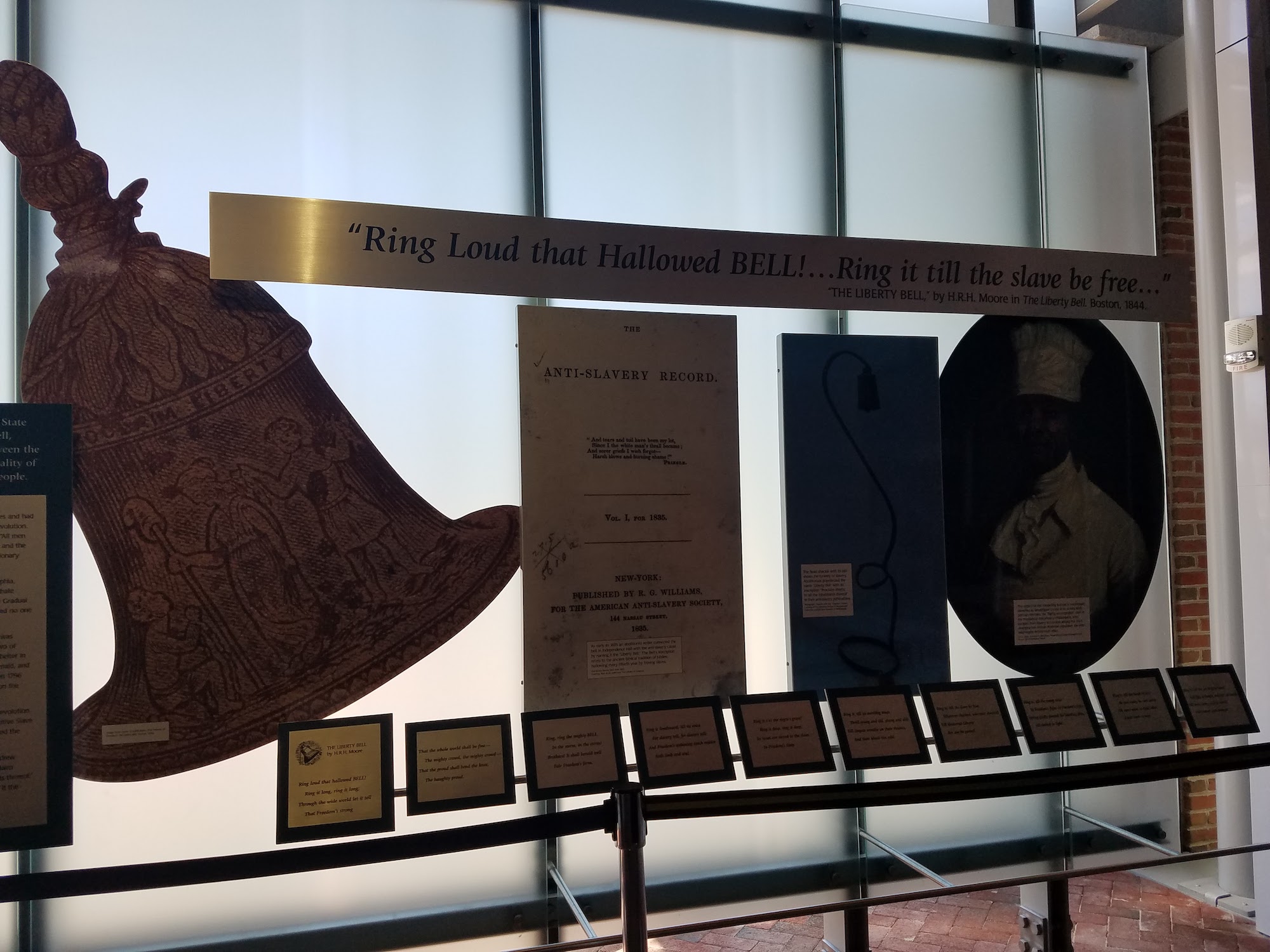
Right next to the Liberty Bell Center where the Liberty Bell is displayed is the President's House.
The President's House was the third U.S. Presidential Mansion. George Washington occupied it from 1790 to 1797; and John Adams occupied it from 1797 to 1800.
There were nine enslaved Africans who worked in George Washington's presidential household.
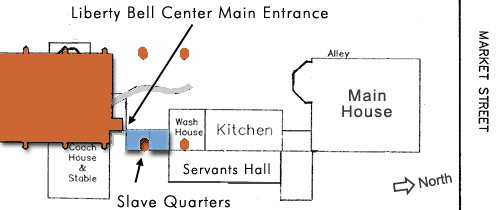
The Slave Quarters are a mere five feet from the door to the new Liberty Bell Center.
https://www.ushistory.org/presidentshouse/slaves/slavequartersfaq.php
Memorial to Enslaved People of African Descent in the United States of America:
The memorial exhibit features African quotes, sayings, symbols, and a list of African countries:
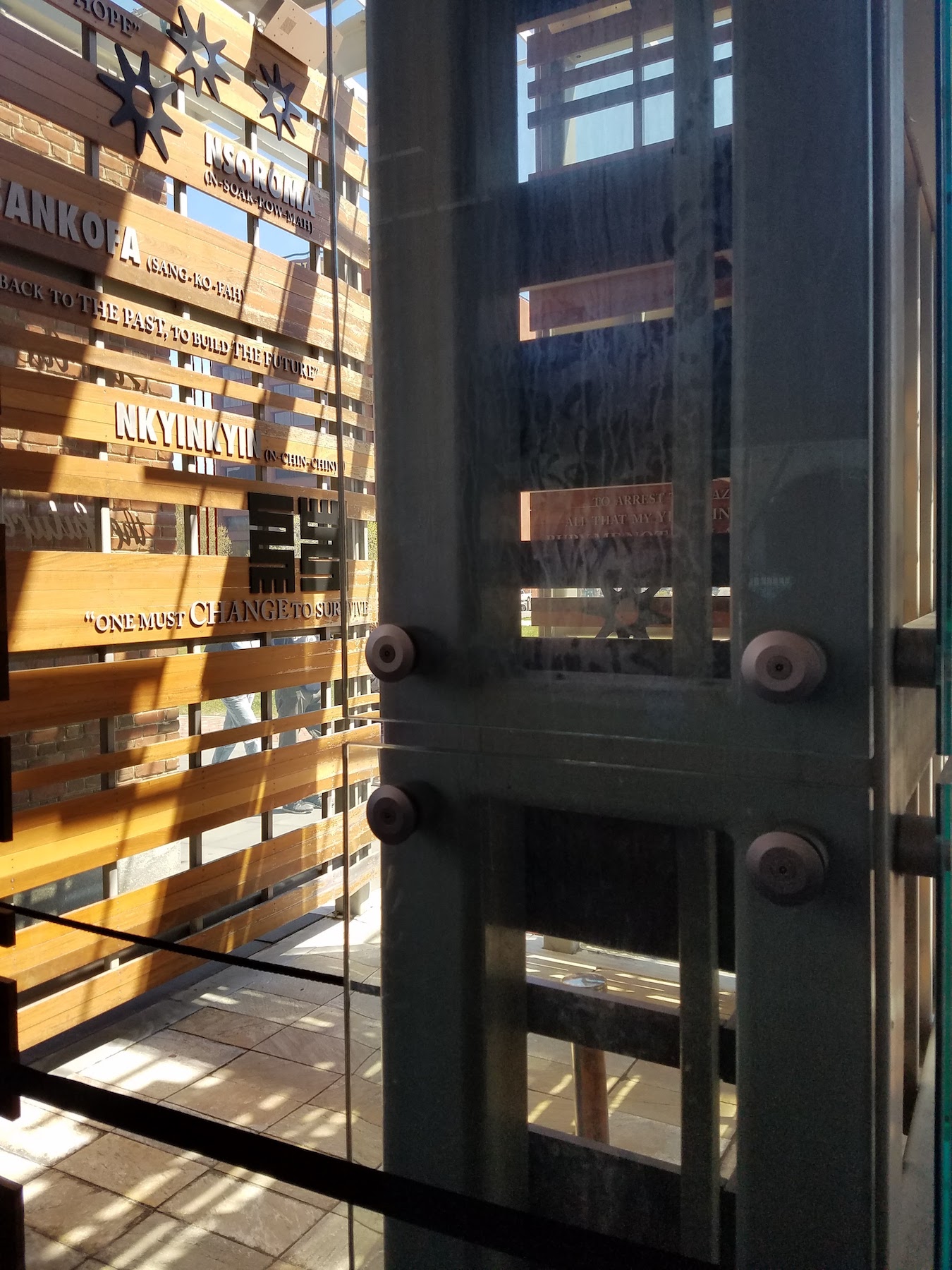
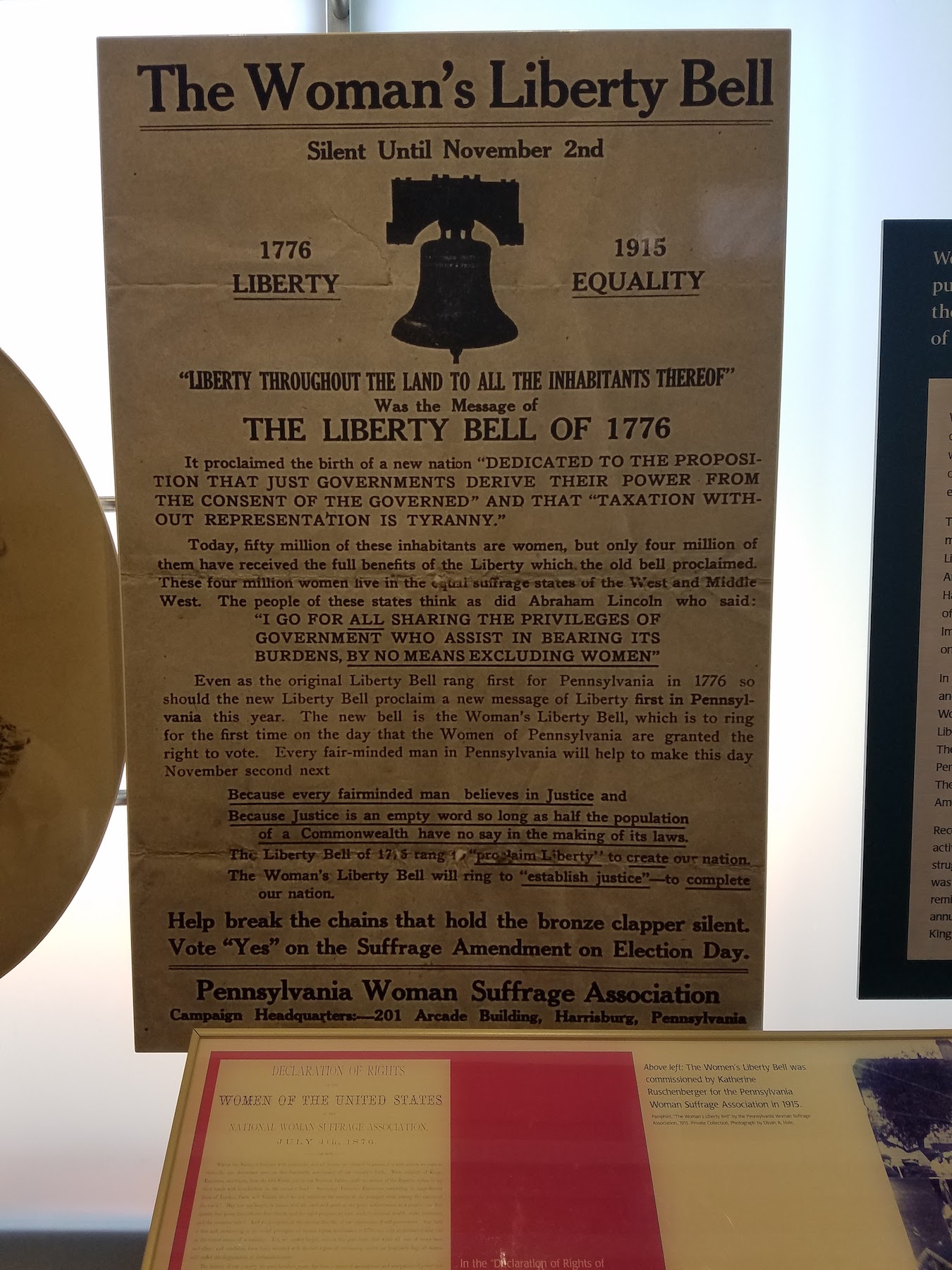
Silent Until November 2nd
1776 LIBERTY
1915 EQUALITY
"LIBERTY THROUGHOUT THE LAND TO ALL THE INHABITANTS THEREOF"
Was the Message of
THE LIBERTY BELL OF 1776
It proclaimed the birth of a new nation "DEDICATED TO THE PROPOSITON THAT JUST GOVERNMENTS DERIVE THEIR POWER FROM THE CONSENT OF THE GOVERNED" AND THAT "TAXATION WITHOUT REPRESENTATION IS TYRANNY"
Today, fifty million of these inhabitants are women, but only four million of them have received the full benefits of the Liberty which the old bell proclaimed.
These four million women live in the equal suffrage states of the West and Middle West. The people of these states think as did Abraham Lincoln who said:
Even as the original Liberty Bell rang first for Pennsylvania in 1776 so should the new Liberty Bell proclaim a new message of Liberty first in Pennsylvania this year. The new bell is the Woman's Liberty Bell, which is to ring for the first time on the day that the Women of Pennsylvania are granted the right to vote. Every fair-minded man in Pennsylvania will help to make this day November second next
Because Justice is an empty word so long as half the population of a Commonwealth have no say in the making of its laws.
The Liberty Bell of 1775 rang to "proclaim Liberty to create our nation.
The Woman's Liberty Bell will ring to "establish justice" - to complete our nation.
Help break the chains that hold the bronze clapper silent.
Vote "Yes" on the Suffrage Amendment on Election Day.
Pennsylvania Woman Suffrage Association
Campaign Headquarters: -201 Arcade Building, Harrisburg, Pennsylvania
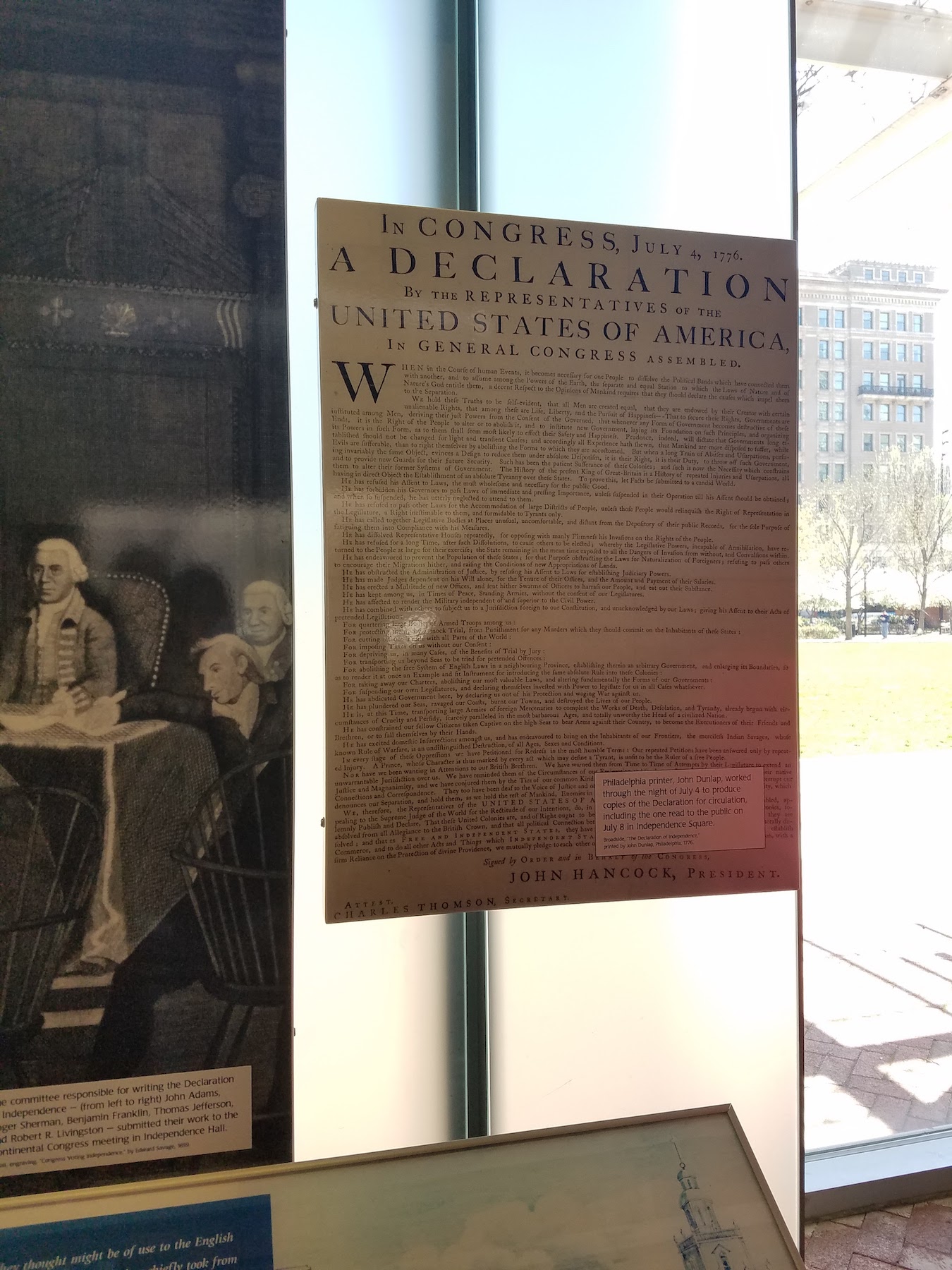
Philadelphia printer, John Dunlap, worked through the night of July 4 to produce copies of the Declaration for circulation, including the one read to the public on July 8 in Independence Square.
The Liberty Bell, previously called the State House Bell or Old State House Bell, is an iconic symbol of American independence, located in Philadelphia, Pennsylvania.Liberty Bell:
- Once placed in the steeple of the Pennsylvania State House (now renamed Independence Hall). Today is located across the street in the Liberty Bell Center in Independence National Historical Park.
- The bell was commissioned in 1752 by the Pennsylvania Provincial Assembly from the London firm of Lester and Pack (known subsequently as the Whitechapel Bell Foundry)
- It was cast with the lettering "Proclaim LIBERTY Throughout all the Land unto all the Inhabitants Thereof", a Biblical reference from the Book of Leviticus (25:10).
- The bell first cracked when rung after its arrival in Philadelphia, and was twice recast by local workmen John Pass and John Stow, whose last names appear on the bell.
- In its early years, the bell was used to summon lawmakers to legislative sessions and to alert citizens about public meetings and proclamations.
Although no immediate announcement was made of the Second Continental Congress's vote for independence—and so the bell could not have rung on July 4, 1776, related to that vote—bells were rung on July 8 to mark the reading of the United States Declaration of Independence.
- After American independence was secured, the bell fell into relative obscurity until, in the 1830s, the bell was adopted as a symbol by abolitionist societies, who dubbed it the "Liberty Bell".
- The bell acquired its distinctive large crack some time in the early 19th century—a widespread story claims it cracked while ringing after the death of Chief Justice John Marshall in 1835.
The bell became famous after an 1847 short story claimed that an aged bellringer rang it on July 4, 1776, upon hearing of the Second Continental Congress's vote for independence. Although the bell did not ring for independence on that July 4, the tale was widely accepted as fact, even by some historians.Beginning in 1885, the city of Philadelphia—which owns the bell—allowed it to go to various expositions and patriotic gatherings. The bell attracted huge crowds wherever it went, additional cracking occurred, and pieces were chipped away by souvenir hunters. The last such journey occurred in 1915, after which the city refused further requests.
After World War II, Philadelphia allowed the National Park Service to take custody of the bell, while retaining ownership.
It was moved from its longtime home in Independence Hall to a nearby glass pavilion on Independence Mall in 1976, and then to the larger Liberty Bell Center adjacent to the pavilion in 2003.
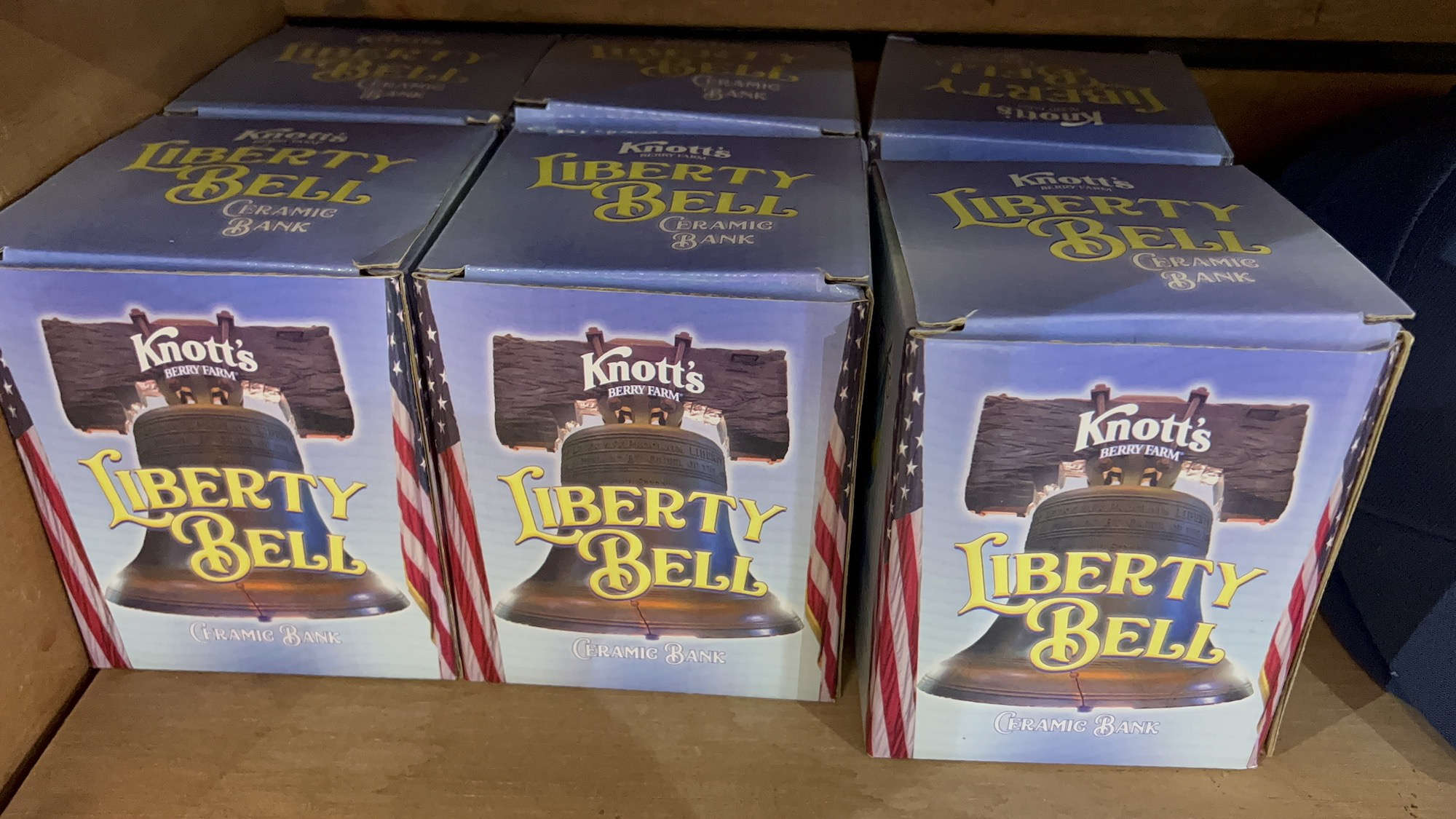
[https://www.eatlife.net/knotts-berry-farm/general-store.php]
